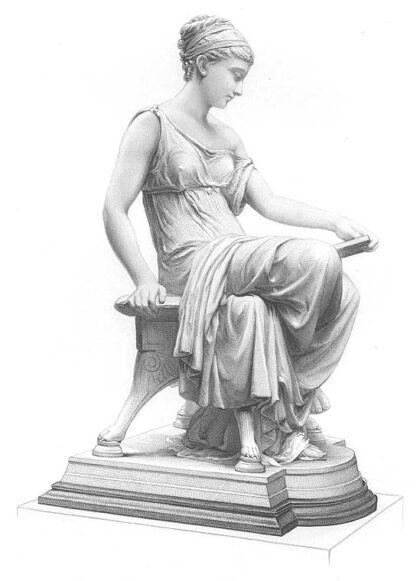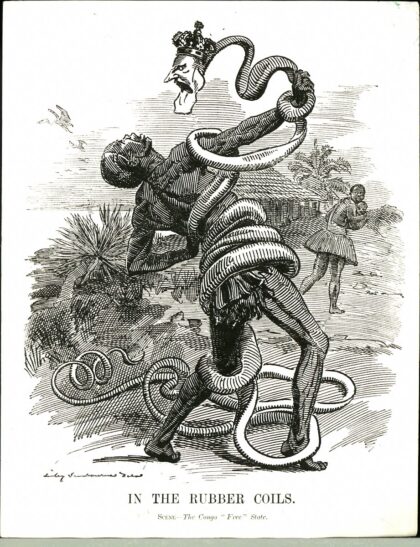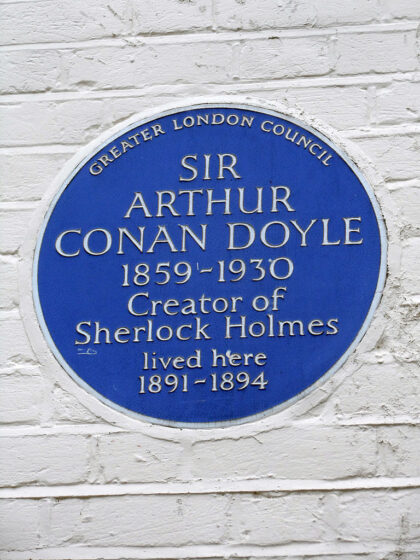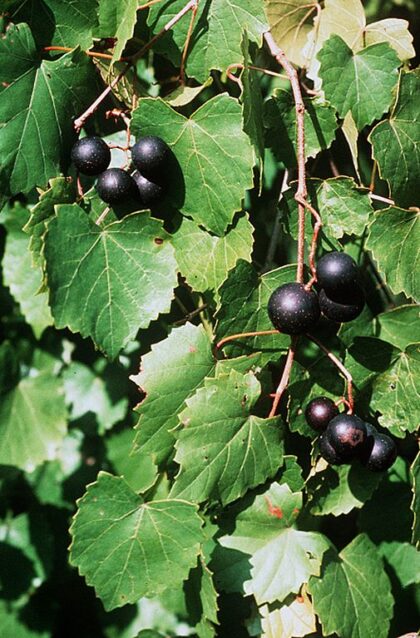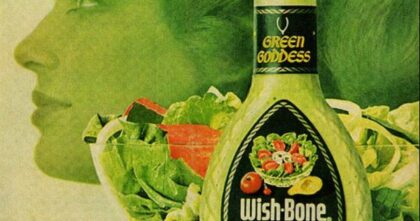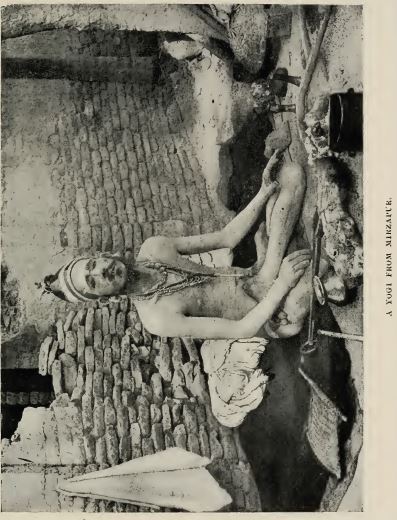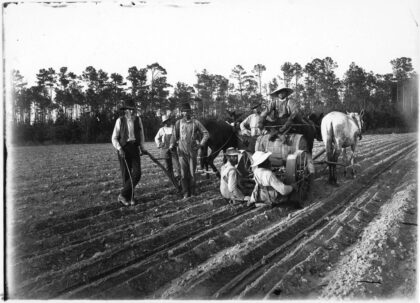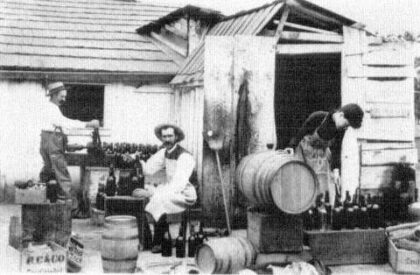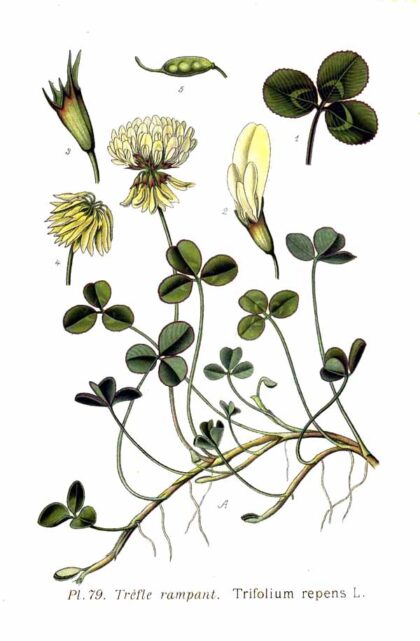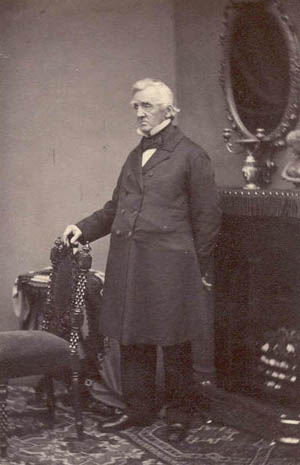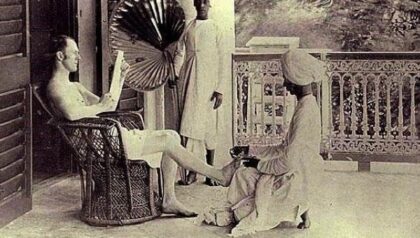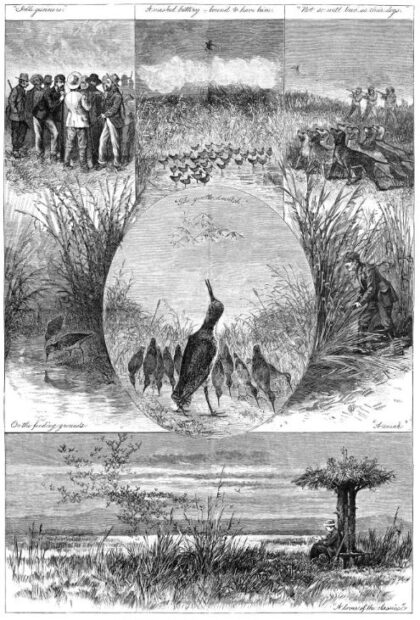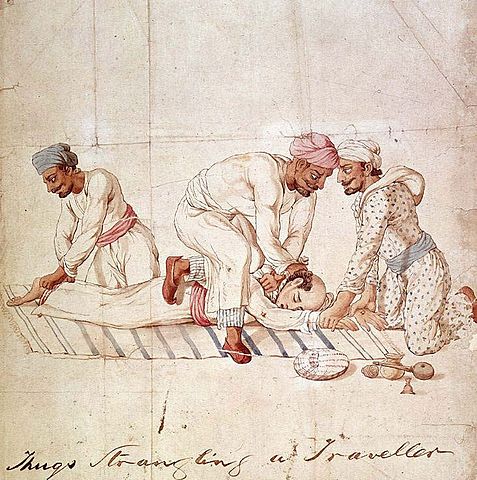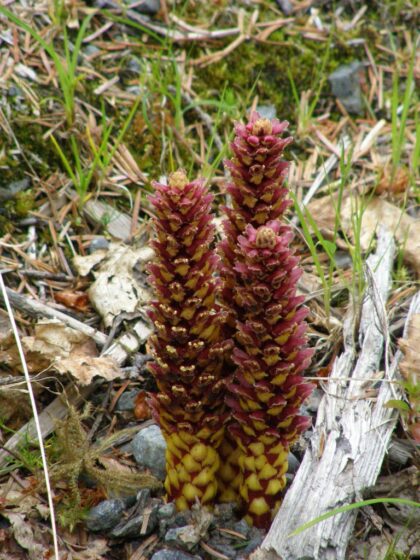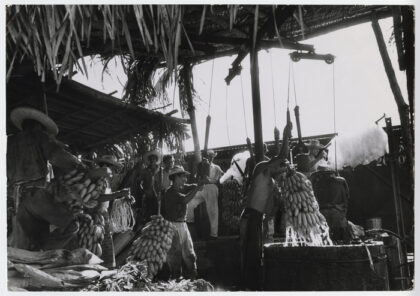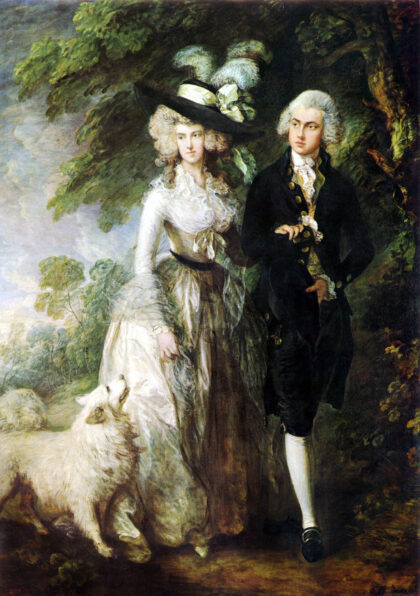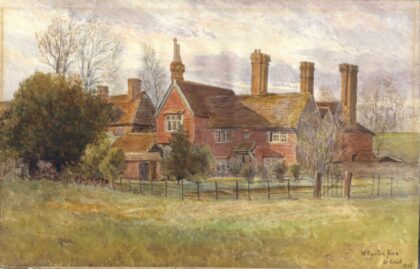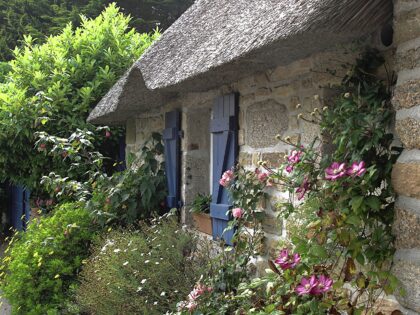
|
April 12th, 2018
Click here to read The First Greek Book by John Williams White IN MEMORIAM JOHN WILLIAMS WHITE The death, on May 9, of John Williams White, professor of Greek in Harvard University, touches a large number of classical workers who have come into relations with him through his teaching or his writings, and concerns many a student, past or present, who may not have known his name, or a word of the language and literature which he professed. Continue reading The First Greek Book by John Williams White HomeTop of Pg.Category: Essays April 3rd, 2018
 Man looks at severed hand and foot….for refusing to climb a tree to cut rubber for King Leopold
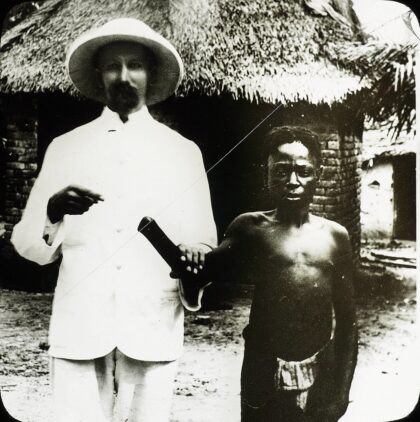 Victim of King Leopold of Belgium Click on the link below for faster download. HomeTop of Pg.Category: Essays April 3rd, 2018
The following are transcripts of two letters written by the Founding Father Thomas Jefferson on the subject of seed saving. “November 27, 1818. Monticello. Thomas Jefferson to Henry E. Watkins, transmitting succory seed and outlining the culture of succory.” [Transcript] Dear Sir, Your fav[ou]r of the 6th. did not get to hand till the 23d. and I now with pleasure send you as much of the succory seed as can well go under the volume of a letter. as I mentioned to our colleagues at the Gap, I had forgotten which of them expressed a willingness to try this plant, and therefore I have waited for their application having taken care to have a plenty of seed saved. Continue reading Thomas Jefferson Correspondence — On Seed Saving and Sharing HomeTop of Pg.Category: Essays April 2nd, 2018
HomeTop of Pg.Category: Country House Cooking April 2nd, 2018  Carya Nuts This Handbook is Published by SLMA or the Southeastern Lumber Manufacturer’s Association Click here to read the handbook or click on the link below for a faster download. HomeTop of Pg.Category: Essays April 12th, 2018
The following recipes are from a small booklet entitled 500 Delicious Salads that was published for the Culinary Arts Institute in 1940 by Consolidated Book Publishers, Inc. 153 N. Michigan Ave., Chicago, Ill. If you have been looking for a way to lighten up your salads and be free of calorie filled store bought salad dressings, then the following just might do the trick. Continue reading The Perfect Salad Dressing HomeTop of Pg.Category: Country House Cooking April 2nd, 2018 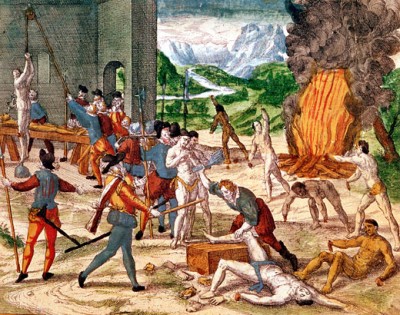 Hernando de Soto (c1496-1542) Spanish explorer and his men torturing natives of Florida in his determination to find gold. Hand-coloured engraving. John Judkyn Memorial Collection, Freshford Manor, Bath The print above depicts Spanish explorer Hernando de Soto and his band of conquistadors torturing Florida natives in order to extract information on where one might find gold on the peninsula. The print is one of many in a collection of prints that belonged to John Judkyn, a Briton who was a noted antiques dealer, collector, and conservator. I discovered this print on the website for The American Museum in Bath, a British museum that Judkyn helped found and where his life-long collection is housed. Continue reading The American Museum in Britain — From Florida to Bath HomeTop of Pg.Category: Essays April 2nd, 2018
The following recipes form the most popular items in a nine-course dinner program: BIRD’S NEST SOUP Soak one pound bird’s nest in cold water overnight. Drain the cold water and cook in boiling water. Drain again. Do this twice. Clean the bird’s nest. Be sure to take out all feathers and loose particles. Continue reading Chinese 9 Course Dinner HomeTop of Pg.Category: Country House Cooking April 2nd, 2018
The Effect of Magnetic Fields on Wound Healing Steven L. Henry, MD, Matthew J. Concannon, MD, and Gloria J. Yee, MD Objective: Magnets are purported to aid wound healing despite a paucity of scientific evidence. The purpose of this study was to evaluate the effect of static magnetic fields on cutaneous wound healing in an animal model. The literature was reviewed to explore the historical and scientific basis of magnet therapy and to define its current role in the evidence-based practice of plastic surgery. Continue reading The Effect of Magnetic Fields on Wound Healing HomeTop of Pg.Category: Essays April 2nd, 2018  King Leopold Butcher of the Congo For the somewhat startling suggestion in the heading of this interview, the missionary interviewed is in no way responsible. The credit of it, or, if you like, the discredit, belongs entirely to the editor of the Review, who, without dogmatism, wishes to pose the question as a matter for serious discussion. Since Charles I’s head was cut off, opposite Whitehall, nearly two hundred and fifty years ago, the sanctity which doth hedge about a king has been held in slight and scant regard by the Puritans and their descendants. Hence there is nothing antecedently shocking or outrageous in the discussion of the question whether the acts of any Sovereign are such as to justify the calling in of the services of the public executioner. It is not, of course, for a journalist to pronounce judgment, but no function of the public writer is so imperative as that of calling attention to great wrongs, and no duty is more imperious than that of insisting that no rank or station should be allowed to shield from justice the real criminal when he is once discovered. Continue reading Ought King Leopold to be Hanged? HomeTop of Pg.Category: Essays April 2nd, 2018
Are you considering purchasing a copper water pitcher for storing drinking water but have questions about the effects on your health? The following study may help jump-start your research. Storing Drinking-water in Copper pots Kills Contaminating Diarrhoeagenic Bacteria ABSTRACT Microbially-unsafe water is still a major concern in most developing countries. Although many water-purification methods exist, these are expensive and beyond the reach of many people, especially in rural areas. Ayurveda recommends the use of copper for storing drinking-water. Therefore, the objective of this study was to evaluate the effect of copper pot on microbially-contaminated drinking-water. The antibacterial effect of copper pot against important diarrhoeagenic bacteria, including Vibrio cholerae O1, Shigella flexneri 2a, enterotoxigenic Escherichia coli, enteropathogenic E. coli, Salmonella enterica Typhi, and Salmonella Paratyphi is reported. When drinking-water (pH 7.83±0.4; source: ground) was contaminated with 500 CFU/mL of the above bacteria and stored in copper pots for 16 hours at room temperature, no bacteria could be recovered on the culture medium. Recovery failed even after resuscitation in enrichment broth, followed by plating on selective media, indicating loss of culturability. This is the first report on the effect of copper on S. flexneri 2a, enteropathogenic E. coli, and Salmonella Paratyphi. After 16 hours, there was a slight increase in the pH of water from 7.83 to 7.93 in the copper pots while the other physicochemical parameters remained unchanged. Copper content (177±16 ppb) in water stored in copper pots was well within the permissible limits of the World Health Organization. Copper holds promise as a point-of-use solution for microbial purification of drinking-water, especially in developing countries. Click here to read the entire study. Click here to read more on the topic of water stored in copper vessels.
HomeTop of Pg.Category: Essays April 1st, 2018
WITCHCRAFT, SORCERY, MAGIC AND OTHER PSYCHOLOGICAL PHENOMENA AND THEIR IMPLICATIONS ON MILITARY AND PARAMILITARY OPERATIONS IN THE CONGO This report has been prepared in response to a query posed by ODCS/OPS, Department of the Army, regarding the purported use of witchcraft, sorcery, and magic by insurgent elements in the Republic of the Congo (Leopoldville). Magical practices are said to be effective in conditioning dissident elements and their followers to do battle with Government troops. Continue reading Paramilitary Operations in the Congo: Witchcraft, Sorcery, Magic and Other Psychological Phenomena HomeTop of Pg.Category: Essays April 1st, 2018
Aw, the good old days, meet in the coffee shop with a few friends, click open the Zippo, inhale a glorious nosegay of lighter fluid, fresh roasted coffee and a Marlboro cigarette…. A Meta-analysis of Coffee Drinking, Cigarette Smoking, and the Risk of Parkinson’s Disease
HomeTop of Pg.Category: Essays April 1st, 2018
THE HATHA YOGA PRADIPIKA Translated into English by Panini Office, Allahabad INTRODUCTION. There exists at present a good deal of misconception with regard to the practices of the Haṭha Yoga. People easily believe in the stories told by those who themselves heard them second hand, and no attempt is made to find out the truth by a direct reference to any good treatise. It is generally believed that the six practices, in Haṭha Yoga are compulsory on the student and that besides being dirty, they are fraught with danger to the practiser. This is not true, for these practices are necessary only in the existence of impurities in the Nâdis, and not otherwise. Continue reading The Hatha Yoga Pradipika HomeTop of Pg.Category: Essays April 1st, 2018 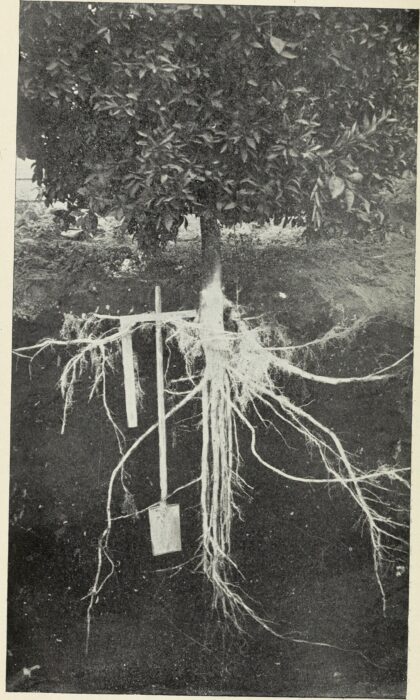 Citrus Fruit Culture THE PRINCIPAL fruit and nut trees grown commercially in the United States (except figs, tung, and filberts) are grown as varieties or clonal lines propagated on rootstocks. Almost all the rootstocks are grown from seed. The resulting seedlings then are either budded or grafted with propagating wood of the desired variety. This practice has come about chiefly because the improved varieties of these fruits and nuts do not come true from seed and are not easily propagated on their own roots from cuttings. Continue reading Seeds for Rootstocks of Fruit and Nut Trees HomeTop of Pg.Category: Essays April 1st, 2018
THE FIRST step in producing a satisfactory crop of tobacco is to use good seed that is true to type. The grower often can save his own seed to advantage, if he wants to. Before topping is done, he should go over the tobacco field carefully to pick out desirable seed plants. When he has decided on the ideal type of plant, he should select the plants that conform to this type for producing seed. One plant produces about one-half ounce of viable seed (about 150 thousand seeds), which is enough for 100 square yards in seedbed area and, if conditions are favorable, enough seedlings to plant 2 to 5 acres. Continue reading Producing and Harvesting Tobacco Seed HomeTop of Pg.Category: Essays April 1st, 2018
Wine Making Grapes are the world’s leading fruit crop and the eighth most important food crop in the world, exceeded only by the principal cereals and starchytubers. Though substantial quantities are used for fresh fruit, raisins, juice and preserves, most of the world’s annual production of about 60 million metric tons is used for dry (nonsweet) wine. Wine is of great antiquity, as every Bible reader knows, and a traditional and important element in the daily fare of millions. Used in moderation, it is wholesome and nourishing, and gives zest to the simplest diet. It is a source of a broad range of essential minerals, some vitamins, and easily assimilated calories provided by its moderate alcoholic content. Continue reading Wine Making HomeTop of Pg.Category: Wine, Cordials, & Spirits, Essays April 1st, 2018
* Blossoms are the flowers, not the leaves. A variety of clovers can be used. A conversation with a local farmer could be rewarding here.
HomeTop of Pg.Category: Wine, Cordials, & Spirits April 1st, 2018
What follows is a chapter from Nathaniel Bagshaw Ward’s 1852 treatise on terrarium gardening. ON THE NATURAL CONDITIONS OF PLANTS. To enter into any lengthened detail on the all-important subject of the Natural Conditions of Plants would occupy far too much space; yet to pass it by without special notice, in any work treating of their cultivation, would be impossible. Without a knowledge of the laws which regulate their growth, all out attempts must be empirical and more or less abortive. When we survey the vegetation on the surface of the earth, we are struck with the endless diversities of form which present themselves to our astonished gaze, from the magnificent palms of the Tropics and the bread-fruit of the Polynesian Islands to the reindeer moss of Lapland, or the red snow of the Arctic regions. Yet the growth of all is governed by immutable laws, and they owe their forms to varying climatal conditions. Continue reading On the Growth of Plants in Closely Glazed Cases by Nathaniel Bagwell Ward HomeTop of Pg.Category: Essays March 31st, 2018 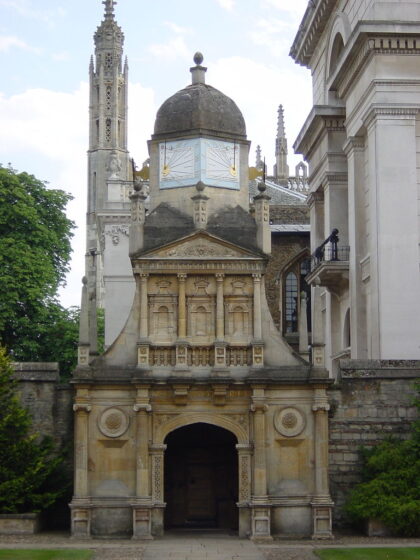 Gate of Honour, Caius Court, Gonville & Caius Gonville & Caius College, known as Caius and pronounced keys was founded in 1348 by Edmund Gonville, the Rector of Terrington St Clement in Norfolk. The first name was thus Goville Hall and it was dedicated to the Annunciation of the Blessed Virgin Mary. Caius College, along with Pembroke, Corpus Christi, and Trinity Hall were all founded within a decade of one another. Many believe this proliferation of colleges came about due to the plague or the Black Death of 1348 which took the lives of many learned men, thus these colleges are often attributed “plague colleges”, established to cultivate a new generation of educated men. Three parcels of land for the college was purchased by Gonville on March 5th 1347. In January 1348 King Edward III granted the right to establish and endow a Hall. Edmund Gonville did not have the resources necessary to properly endow the college and following his death in the summer of 1351, the Bishop of Norwich, William Batemen took control of the finances, and brought in further endowment. The College remained under-endowed until 1557 when a former student named John Keys, who spelled his name Caius on legal documents, stepped in from his successful City of London medical practice. He offered to re-found his alma mater as Gonville and Caius College. In 1558 Dr. Caius was elected Master. Dr. Caius substantially increased the endowment during his tenure as Master through additional land purchases by use of his own funds and donations. Upon part of the land donated by Dr. Caius today sits Tree Court as shown in the photo below. Upon his death in 1573, he was buried in the College Chapel. 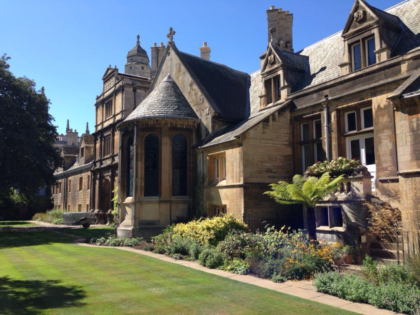 University of Cambridge, Gonville and Caius Tree Court, Cambridge Today, March 31st, 2018, six porters from the college shall serve as pall bearers for the funeral of world-renowned scientist Dr. Stephen Hawking. Hawking was educated at Caius and it served as his academic home for over 52 years. 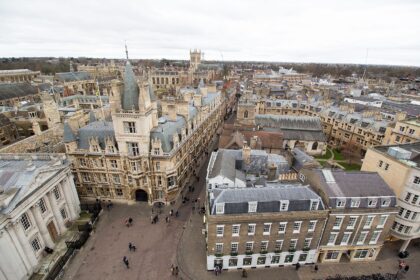 View of Cambridge from Great St. Mary’s Gate Category: Essays March 30th, 2018
Filed under Miscellaneous. The Jubbulpore School of Industry is so thriving that the pupils, 800 in number, are obliged to work till ten o’clock at night to complete their orders; this they do most cheerfully. They are all Thugs, or the children of Thugs, and the hands which now ply the shuttle, or the axe, or the saw, have through the greater portion of their lives been familiar only with the poison cup or strangling rope. Maulmain—On the 23rd November, the town of Maulmain was nearly blown up by the explosion of two hundred casks of gunpowder, which accidentally caught fire. Captain Impey. —Extract of a letter from Maulmain.—”The The intelligence which has reached us of Captain Impey is not of the most positive nature, He is at one time said to be marching at the head of 20,000 Burmans to the attack of the Shans; at anothertime he is reported to be at Ava tendering his allegiance to that court and government, and the latest account is that that unfortunate and misguided man is ‘lying sick at Kherannee, Pappo’s village, having neither joined the Shans nor the Burmans. I have reason to believe that this letter is the correct statement. His friend Mr. Tracey some time ago applied to Government for the grant of a forest on the east bank of the Thoung-yeen, and pending the boon, both himself and Capt. Impey are lying upon their oars. As soon as the sanction is obtained, both intend to set vigourously to work in the timber trade, so that all the reports of his heading an army, and all that sort of stuff, is sheer downright nonsense.”—Englishman HomeTop of Pg.Category: Dispatches from the Empire October 6th, 2023 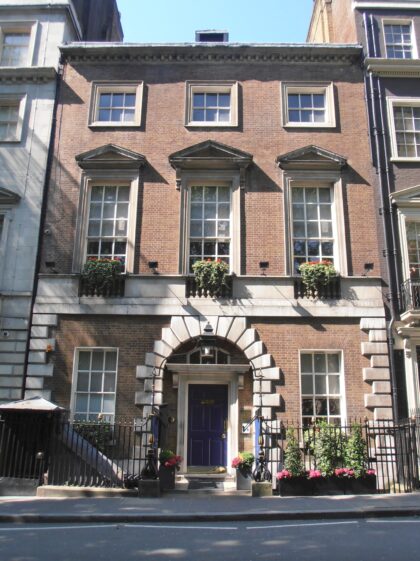 The Clermont Club Reprint from London Bisnow/UK At £23M, its sale is not the biggest property deal in the world. But the Clermont Club casino in Berkeley Square in London could lay claim to being the most significant address in modern finance — it is where the concept of what is today called private equity investing was dreamed up by a group of British gambling buddies. In 1962, gambler and members club owner John Aspinall opened the Clermont Club in the Grade I listed 44 Berkeley Square in Mayfair, a townhouse built in 1740. The private casino and members club was frequented by myriad members of the British aristocracy; the James Bond holy trinity of Ian Fleming, Roger Moore and Cubby Broccoli; and Lord Lucan, the British peer who disappeared after his family’s nanny was murdered. But it was also the social hub for a group of businessmen who changed the face of investing in finance and property, men who were drawn to the club by their taste for risk and the high-stakes games that took place there. The group and their influence is explored in the 2000 Adam Curtis documentary series “The Mayfair Set”. The group included Jim Slater, the accountant and finance columnist-turned investor, who pioneered the concept of buying listed companies because they owned assets like property that were held at cost on the balance sheet, but were actually worth much more. His company, Slater Walker, borrowed heavily to take the companies private, sold off assets to pay back the debt, then sold the leaner, more efficient companies at a profit. At the time it was called asset stripping, and was despised by the financial establishment, which until that time had been something of a sleepy club. But the template was drawn that would go on to form the basis of the private equity industry. At the Clermont Club, Slater became friends with Sir James Goldsmith, who after undertaking a similar strategy with multiple companies in the UK took the idea to the U.S., where he was in the vanguard of “corporate raiders” that established the leveraged buyout industry that spawned the private equity giants of today. At one point he was one of the biggest owners of timberland in the U.S., owning forests worth more than $1B that had been held on the balance sheet of Crown Zellerbach for just $12.5M. Private equity firms like Blackstone and Carlyle got their starts investing in real estate when they realised that the companies their buyout teams owned had hugely undervalued property assets. “Some people actually seek risk, and they put themselves at risk voluntarily,” Aspinall said in 1971 of gamblers and investors like Goldsmith and Slater. “I think this is a spirit to be admired, and it is the spirit that built the prosperity that everyone in this country [Britain] is enjoying today. This country was created by adventurers, by merchant adventurers, by pirates if you like.” Curtis’ documentary said the form of capitalism created by Slater, Goldsmith and fellow Clermont regular Tiny Rowland, the mining magnate, deeply influenced politicians like Margaret Thatcher and Ronald Reagan, and led to politicians ceding control of politics, markets and society more generally to market forces. In a quirk of fate, the UK headquarters of Blackstone is about 50 metres away from the Clermont Club at 40 Berkeley Square. The club was closed in 2018, and has been bought by Mayfair Casinos Limited, which owns the Horizons Casino on Leicester Square. It plans to refurbish and reopen the casino. It was sold by GL Limited, a company which owns 17 hotels in London including several operated under the Thistle brand. It bought the Clermont for £31M in 2006. Category: Essays March 30th, 2018
Snipe shooting-Epistle on snipe shooting, from Ned Copper —— “Si sine amore jocisque —— I LOVE shooting. It is enjoyed in the open air. It removes one from the vicinity of flat-roofed, candle-pillared, sun-dried, brick-built, mulligatawny looking houses. You pursue it alone, or, in the society of a friend, equally well. Occasionally it is (I allow) rather hot work, but to a man whose particular taste may lead him to the viewing and enjoying the rays of that great luminary, the sun, shooting affords him the very best opportunity. A good day’s snipe shooting is however, in my opinion, sufficiently exciting to keep away all thoughts and fidgetings about either his power, influence or effects. As yet old Phœbus has behaved with great liberality and kindness towards me, nor has he ever even shown an inclination in his hottest moments to quarrel. He has now, for some years past, thrown his burning beams pretty freely about my head when in pursuit of the snipe, and up to this day I am unscathed. Continue reading Snipe Shooting HomeTop of Pg.Category: Essays March 29th, 2018
The existence of large bodies of men having no other means of subsistence than those afforded by plunder, is, in all countries, too common to excite surprise; and, unhappily, organized bands of assassins are not peculiar to India! The associations of murderers known by the name of Thugs present, however, so many remarkable points of character and manners, that curiosity may reasonably be excited to inquire into the history, and ascertain the feelings, opinions, and motives of persons differing, in many respects, so widely even from all other followers of their own horrible occupation. In different parts of India, these ruffians assume, and have been designated by, various names, derived either from the mode by which they dispatch their victims-from the purpose for which they destroy life, or from the arts by which they inveigle their prey to destruction. In the more northern parts of India, these murderers are called Thugs, the name by which they are most generally known among Europeans. This term signifies It “deceiver.” In some provinces to the southward, according to Dr. Sherwood, they have obtained the name of Phansigars, or It stranglers,” from the Hindostanee word phanai, a It noose.” By the same authority it is stated, that in the Tamul language they are called Ari Tulucar, or Mussulman It noosers”; in Canarese, Tanti Calleru, implying” thieves who use a wire or catgut noose”; and in Telagu, Warlu Wahndlu, or Warlu Vayshay Wahndloo, meaning people who use the noose.” Continue reading Life Among the Thugee HomeTop of Pg.Category: Essays March 29th, 2018
Liquorice, the roots of Glycirrhiza Glabra, a perennial plant, a native of the south of Europe, but cultivated to some extent in England, particularly at Mitcham, in Surrey. Its root, which is its only valuable part, is long, fibrous, of a yellow colour, and when fresh, very juicy. The liquorice root grows wild in many parts of Greece, and especially in the province of Achaia, at Corinth and Missolonghi, in great abundance; its quality is considered very good, and has induced many to undertake its manufacture. Large quantities are annually prepared for exportation. Continue reading Fruits of the Empire: Licorice Root and Juice HomeTop of Pg.Category: Essays March 29th, 2018
The following research discussion is from a study funded by the U.S. National Institute of Health entitled: Boschniakia rossica prevents the carbon tetrachloride-induced hepatotoxicity in rat. It may be of interest to heavy drinkers. Continue reading Of Interest to Heavy Drinkers: Cleansing the Liver with Northern Ground Cone (Boschniaka rossica) HomeTop of Pg.Category: Essays March 29th, 2018
From Conquest of the Tropics by Frederick Upham Adams Chapter VI – Birth of the United Fruit Company Only those who have lived in the tropic and are familiar with the hazards which confront the cultivation and marketing of its fruits can readily understand the motives which impelled a union of the interests of the Boston Fruit Company and those headed by Minor C. Keith. It was not a move calculated to control competition or to rear a monopoly; it was the business step imperatively required to secure the permanency of the banana industry. Continue reading Birth of United Fruit Company HomeTop of Pg.Category: Essays March 29th, 2018
Banana Propagation Reprinted from the International Institute of Tropical Agriculture (IITA.org) The traditional means of obtaining banana planting material (“seed”) is to acquire suckers from one’s own banana garden, from a neighbor, or from a more distant source. This method served to spread common varieties around the world and to multiply them in their new locations. This system can be modified to produce more banana suckers or shoots by manipulating banana corms to allow more buds to sprout. One such method that is described here is called macropropagation. A higher tech procedure to rapidly produce many plants in just a few generations of propagation is called tissue culture. In tissue culture, plants are first surface sterilized and then grown in aseptic culture in test tubes using an artificial growth medium based on a gelling agent like agar. The tender tissue-cultured plants can then be planted in the field after rooting and hardening under protected conditions. Continue reading Banana Propagation HomeTop of Pg.Category: Essays March 28th, 2018
Whose passions not his masters are; Who envies none that chance doth raise, Who hath his life from rumours freed; Who God doth late and early pray This man is freed from servile bands Sir Henry Wotton HomeTop of Pg.Category: Poems March 28th, 2018  Twinings London – photo by Elisa.rolle Is the tea in your cup genuine? The fact is, had one been living in the early 19th Century, one might occasionally encounter a counterfeit cup of tea. Food adulterations to include added poisonings and suspect substitutions were a common problem in Europe at the time. Continue reading Cup of Tea? To be or not to be HomeTop of Pg.Category: Essays March 28th, 2018 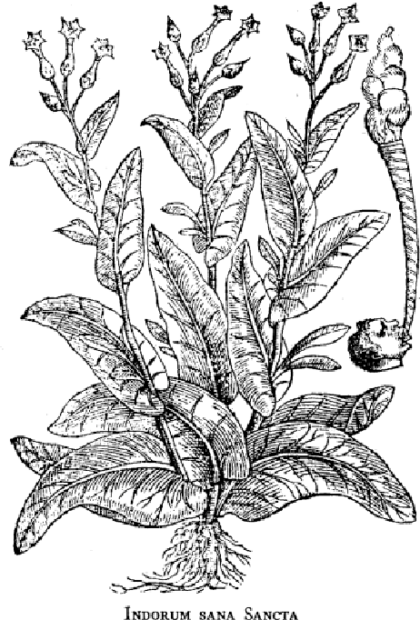 The first published illustration of Nicotiana tabacum by Pena and De L’Obel, 1570–1571 (shrpium adversana nova: London). Tobacco can be used for medicinal purposes, however, the ongoing American war on smoking has all but obscured this important aspect of ancient plant. Tobacco is considered to be an indigenous plant of the Americas and over 60 species are known to exist. Columbus first ran across cultivated tobacco in 1492. The word tobacco is a misnomer as the original names given to the various species included petum, betum, cogioba, cohobba, quauhyetl, picietl and yietl. Continue reading Tobacco as Medicine HomeTop of Pg.Category: Essays |
Indian Modes of Hunting – Setting Fox Traps
Aug. 13, 1898 Forest and Stream, Pg. 125 Game Bag and Gun. Indian Modes of Hunting. III.—Foxes. The fox as a rule is a most wily animal, and numerous are the stories of his cunning toward the Indian hunter with his steel traps. Read more → Paramilitary Operations in the Congo: Witchcraft, Sorcery, Magic and Other Psychological Phenomena
WITCHCRAFT, SORCERY, MAGIC AND OTHER PSYCHOLOGICAL PHENOMENA AND THEIR IMPLICATIONS ON MILITARY AND PARAMILITARY OPERATIONS IN THE CONGO This report has been prepared in response to a query posed by ODCS/OPS, Department of the Army, regarding the purported use of witchcraft, sorcery, and magic by insurgent elements in the Republic [...] Read more → Historical Uses of Arsenic
The arsenicals (compounds which contain the heavy metal element arsenic, As) have a long history of use in man – with both benevolent and malevolent intent. The name ‘arsenic’ is derived from the Greek word ‘arsenikon’ which means ‘potent'”. As early as 2000 BC, arsenic trioxide, obtained from smelting copper, was used [...] Read more → Unarmed Combat – Imperial War Museum ArchivesFox Hunting Season Opens 1935 – Heythrop Country at Lower Swell, near Stow-in-the-Wold, GloucestershireHome Top of Pg. Read more → Glimpses from the Chase
From Fores’s Sporting Notes and Sketches, A Quarterly Magazine Descriptive of British, Indian, Colonial, and Foreign Sport with Thirty Two Full Page Illustrations Volume 10 1893, London; Mssrs. Fores Piccadilly W. 1893, All Rights Reserved. GLIMPSES OF THE CHASE, Ireland a Hundred Years Ago. By ‘Triviator.’ FOX-HUNTING has, like Racing, [...] Read more → Commercial Fried Fish Cake Recipe
Dried Norwegian Salt Cod Fried fish cakes are sold rather widely in delicatessens and at prepared food counters of department stores in the Atlantic coastal area. This product has possibilities for other sections of the country. Ingredients: Home Top of [...] Read more →Winter Fox Hunt in Michigan, USA – Fantastic FootageHome Top of Pg. Read more → Thomas Jefferson’s Garden BookHome Top of Pg. Read more → WelcomeOrigin of the Apothecary
ORIGIN OF THE APOTHECARY. The origin of the apothecary in England dates much further back than one would suppose from what your correspondent, “A Barrister-at-Law,” says about it. It is true he speaks only of apothecaries as a distinct branch of the medical profession, but long before Henry VIII’s time [...] Read more → Magna Carta: Myth and Meaning – Discussion at the Royal Institution
Note on Watercolour: F.A. Molony (fl. 1930-1938) was a Major in the Royal Engineers. The National Army Museum hold his work. His work was also shown at an exhibition of officers work at the R.B.A. Galleries (Army Officers’ Art Society) Description from Youtube: June 2015 will see [...] Read more → Recipes From Down Under: Kangaroo CutsFresh Water Angling – The Two Crappies
July 2, 1898 Forest and Stream, Fresh-Water Angling. No. IX.—The Two Crappies. BY FRED MATHER. Fishing In Tree Tops. Here a short rod, say 8ft., is long enough, and the line should not be much longer than the rod. A reel is not [...] Read more → Books of Use to the International Art Collector
Hebborn Piranesi Before meeting with an untimely death at the hand of an unknown assassin in Rome on January 11th, 1996, master forger Eric Hebborn put down on paper a wealth of knowledge about the art of forgery. In a book published posthumously in 1997, titled The Art Forger’s Handbook, Hebborn suggests [...] Read more → The Birdman of St. James ParkHome Top of Pg. Read more → 44 Berkeley Square
The Clermont Club Reprint from London Bisnow/UK At £23M, its sale is not the biggest property deal in the world. But the Clermont Club casino in Berkeley Square in London could lay claim to being the most significant address in modern finance — it is where the concept of what is today [...] Read more → American Farming Circa 1954Home Top of Pg. Read more → The English Tradition of Woodworking
THE sense of a consecutive tradition has so completely faded out of English art that it has become difficult to realise the meaning of tradition, or the possibility of its ever again reviving; and this state of things is not improved by the fact that it is due to uncertainty of purpose, [...] Read more → The Hatha Yoga Pradipika
THE HATHA YOGA PRADIPIKA Translated into English by PANCHAM SINH Panini Office, Allahabad [1914] INTRODUCTION. There exists at present a good deal of misconception with regard to the practices of the Haṭha Yoga. People easily believe in the stories told by those who themselves [...] Read more → Blunderbuss Mai Tai Recipe
Blackbeard’s Jolly Roger If you’re looking for that most refreshing of summertime beverages for sipping out on the back patio or perhaps as a last drink before walking the plank, let me recommend my Blunderbuss Mai Tai. I picked up the basics to this recipe over thirty years ago when holed up [...] Read more → Country Cabbage and Pea Soup
Add the following ingredients to a four or six quart crock pot, salt & pepper to taste keeping in mind that salt pork is just that, cover with water and cook on high till it boils, then cut back to low for four or five hours. A slow cooker works well, I [...] Read more → Classic Restoration of a Spring Tied Upholstered Chair
? This video by AT Restoration is the best hands on video I have run across on the basics of classic upholstery. Watch a master at work. Simply amazing. Tools: Round needles: https://amzn.to/2S9IhrP Double pointed hand needle: https://amzn.to/3bDmWPp Hand tools: https://amzn.to/2Rytirc Staple gun (for beginner): https://amzn.to/2JZs3x1 Compressor [...] Read more →Gout Remedies
Jan Verkolje Antonie van Leeuwenhoek was the first person to describe gout or uric acid crystals 1679. For one suffering gout, the following vitamins, herbs, and extracts may be worth looking into: Vitamin C Folic Acid – Folic Acid is a B vitamin and is also known as B9 – [Known food [...] Read more →When Life Was Good and So Was the BreadHome Top of Pg. Read more → The First Christian Man Cremated in America
Laurens’ portrait as painted during his time spent imprisoned in the Tower of London, where he was kept for over a year after being captured at sea while serving as the United States minister to the Netherlands during the Revolutionary War. The first Christian white man to be cremated in America was [...] Read more → Making Linen Fabric from Flax Seed, Spinning Flax, & Weaving LinenHome Top of Pg. Read more → The Apparatus of the Stock Market
Sucker The components of any given market place include both physical structures set up to accommodate trading, and participants to include buyers, sellers, brokers, agents, barkers, pushers, auctioneers, agencies, and propaganda outlets, and banking or transaction exchange facilities. Markets are generally set up by sellers as it is in their [...] Read more → How to Sail a Full Rigged Ship
The rigging of an old square rig in London, United Kingdom. Photograph taken by Melongrower. Home Top of Pg. Read more → Hereford Cathedral Choir Easter Sunday 2017Home Top of Pg. Read more → Flawed Law – The Hunting ActRendering Amber Clear for Use in Lens-Making for Magnifying Glass
by John Partridge,drawing,1825 From the work of Sir Charles Lock Eastlake entitled Materials for a history of oil painting, (London: Longman, Brown, Green, and Longmans, 1846), we learn the following: The effect of oil at certain temperatures, in penetrating “the minute pores of the amber” (as Hoffman elsewhere writes), is still more [...] Read more → The Fowling Piece – Part I
THE FOWLING PIECE, from the Shooter’s Guide by B. Thomas – 1811. I AM perfectly aware that a large volume might be written on this subject; but, as my intention is to give only such information and instruction as is necessary for the sportsman, I shall forbear introducing any extraneous [...] Read more → Dame Edith SitwellHome Top of Pg. Read more → The Public Attitude Towards Speculation
Reprint from The Pitfalls of Speculation by Thomas Gibson 1906 Ed. THE PUBLIC ATTITUDE TOWARD SPECULATION THE public attitude toward speculation is generally hostile. Even those who venture frequently are prone to speak discouragingly of speculative possibilities, and to point warningly to the fact that an [...] Read more → The American Museum in Britain – From Florida to Bath
Hernando de Soto (c1496-1542) Spanish explorer and his men torturing natives of Florida in his determination to find gold. Hand-coloured engraving. John Judkyn Memorial Collection, Freshford Manor, Bath The print above depicts Spanish explorer Hernando de Soto and his band of conquistadors torturing Florida natives in order to extract information on where [...] Read more → How to Tie Knots, Bends, and HitchesHome Top of Pg. Read more → Horn Measurement
Jul. 23, 1898 Forest and Stream, Pg. 65 Horn Measurements. Editor Forest and Stream: “Record head.” How shamefully this term is being abused, especially in the past three years; or since the giant moose from Alaska made his appearance in public and placed all former records (so far as [...] Read more → Protecting Rare Books: How to Build a Silverfish Trap
Silverfish damage to book – photo by Micha L. Rieser The beauty of hunting silverfish is that they are not the most clever of creatures in the insect kingdom. Simply take a small clean glass jar and wrap it in masking tape. The masking tape gives the silverfish something to [...] Read more → The Age of Chivalry
KING ARTHUR AND HIS KNIGHTS On the decline of the Roman power, about five centuries after Christ, the countries of Northern Europe were left almost destitute of a national government. Numerous chiefs, more or less powerful, held local sway, as far as each could enforce his dominion, and occasionally those [...] Read more → The Kalmar War
Wojna Kalmarska – 1611 The Kalmar War From The Historian’s History of the World (In 25 Volumes) by Henry Smith William L.L.D. – Vol. XVI.(Scandinavia) Pg. 308-310 The northern part of the Scandinavian peninsula, as already noticed, had been peopled from the remotest times by nomadic tribes called Finns or Cwenas by [...] Read more → The Trump Bible Now Available for Sale at Barnes and NobleThe Racing Knockabout Gosling
The Racing Knockabout Gosling. Gosling was the winning yacht of 1897 in one of the best racing classes now existing in this country, the Roston knockabout class. The origin of this class dates back about six years, when Carl, a small keel cutter, was built for C. H. [...] Read more → Saving Notre DameHome Top of Pg. Read more → How to Make Money – Banking & Insurance – Part I
Royal Exchange and The Bank of England From How to Make Money; and How to Keep it, Or, Capital and Labor based on the works of Thomas A. Davies Revised & Rewritten with Additions by Henry A. Ford A.M. – 1884 CHAPTER XXVI BANKING AND INSURANCE. I [...] Read more → Making Quality Linen and Canvas Painting Panels
Gary Kravit is an airline pilot and artist. He also owns and operates https://theultimatetaboret.com. You may view Gary’s art at https://garrykravitart.blogspot.com/ Home Top of Pg. Read more →The Most Powerful and FREE Import Export Research Database on the Planet
Click here to access the world’s most powerful Import/Export Research Database on the Planet. With this search engine one is able to access U.S. Customs and other government data showing suppliers for any type of company in the United States. Home Top of Pg. Read more →The First Definition of a CocktailHome Top of Pg. Read more → Some Notes on American Ship Worms
July 9, 1898. Forest and Stream Pg. 25 Some Notes on American Ship-Worms. [Read before the American Fishes Congress at Tampa.] While we wish to preserve and protect most of the products of our waters, these creatures we would gladly obliterate from the realm of living things. For [...] Read more → Sir Joshua Reynolds – Notes from Rome
“The Leda, in the Colonna palace, by Correggio, is dead-coloured white and black, with ultramarine in the shadow ; and over that is scumbled, thinly and smooth, a warmer tint,—I believe caput mortuum. The lights are mellow ; the shadows blueish, but mellow. The picture is painted on panel, in [...] Read more → Henry MillerThe First Pineapple Grown in England
First Pineapple Grown in England Click here to read an excellent article on the history of pineapple growing in the UK. Should one be interested in serious mass scale production, click here for scientific resources. Growing pineapples in the UK. The video below demonstrates how to grow pineapples in Florida. [...] Read more →Naval Stores – Distilling Turpentine
Chipping a Turpentine Tree DISTILLING TURPENTINE One of the Most Important Industries of the State of Georgia Injuring the Magnificent Trees Spirits, Resin, Tar, Pitch, and Crude Turpentine all from the Long Leaved Pine – “Naval Stores” So Called. Dublin, Ga., May 8. – One of the most important industries [...] Read more → Pickled Eels
Vintage woodcut illustration of a Eel
This dish is a favorite in Northern Europe, from the British Isles to Sweden. Clean and skin the eels and cut them into pieces about 3/4-inch thick. Wash and drain the pieces, then dredge in fine salt and allow to stand from 30 [...] Read more → Fox Hunting Season 1964Home Top of Pg. Read more → Mrs. Beeton’s Poultry & Game – Cooking Poultry; Baking and Boiling
Baking is a very similar process to roasting: the two often do duty for one another. As in all other methods of cookery, the surrounding air may be several degrees hotter than boiling water, but the food is no appreciably hotter until it has lost water by evaporation, after which it may [...] Read more → A Conversation between H.F. Leonard and K. Higashi
H.F. Leonard was an instructor in wrestling at the New York Athletic Club. Katsukum Higashi was an instructor in Jujitsu. “I say with emphasis and without qualification that I have been unable to find anything in jujitsu which is not known to Western wrestling. So far as I can see, [...] Read more → Platform of the American Institute of Banking in 1919
Resolution adapted at the New Orleans Convention of the American Institute of Banking, October 9, 1919: “Ours is an educational association organized for the benefit of the banking fraternity of the country and within our membership may be found on an equal basis both employees and employers; [...] Read more → How Long is Your Yacht?
Dominion, Royal St. Lawrence Yacht Club,Winner of Seawanhaka Cup, 1898. The Tail Wags the Dog. The following is a characteristic sample of those broad and liberal views on yachting which are the pride of the Boston Herald. Speaking of the coming races for the Seawanhaka international challenge cup, it says: [...] Read more →Message from J. Edgar Hoover Oct. 1, 1933 – John Dillinger Makes the List
Biograph Theater, where John Dillinger was gunned down by the FBI on July 22, 1934 The Great Depression was on—highway based crime was rampant, the gangsters dressed as well as the bankers they robbed, and and Henry Ford’s big beautiful V8 sedan was the getaway car of choice for both wheelman and [...] Read more → Catholic Religious Orders
Saint Francis of Assisi, founder of the mendicant Order of Friars Minor, as painted by El Greco. Catholic religious orderCatholic religious orders are one of two types of religious institutes (‘Religious Institutes’, cf. canons 573–746), the major form of consecrated life in the Roman Catholic Church. They are organizations of laity [...] Read more → David Starkey: Britain’s Last Great Historian
Dr. David Starkey, the UK’s premiere historian, speaks to the modern and fleeting notion of “cancel culture”. Starkey’s brilliance is unparalleled and it has become quite obvious to the world’s remaining Western scholars willing to stand on intellectual integrity that a few so-called “Woke Intellectuals” most certainly cannot undermine [...] Read more → Mrs. Beeton’s Poultry & Game – Choosing Poultry
To Choose Poultry. When fresh, the eyes should be clear and not sunken, the feet limp and pliable, stiff dry feet being a sure indication that the bird has not been recently killed; the flesh should be firm and thick and if the bird is plucked there should be no [...] Read more → Painting Plaster Work and the History of Terra Cotta
The 1896 Victorian terracotta Bell Edison Telephone Building – 17 & 19 Newhall Street, Birmingham, England. A grade I listed building designed by Frederick Martin of the firm Martin & Chamberlain. Now offices for firms of architects. Photographed 10 May 2006 by Oosoom [Reprint from Victoria and Albert Museum included below on [...] Read more → Of Decorated Furniture
DECORATED or “sumptuous” furniture is not merely furniture that is expensive to buy, but that which has been elaborated with much thought, knowledge, and skill. Such furniture cannot be cheap, certainly, but the real cost of it is sometimes borne by the artist who produces rather than by the man who may [...] Read more → A Day in the Life of Scottish Highland GamekeeperHome Top of Pg. Read more → Chronological Catalog of Recorded Lunar Events
In July of 1968, the National Aeronautics and Space Administration(NASA), published NASA Technical Report TR R-277 titled Chronological Catalog of Recorded Lunar Events. The catalog begins with the first entry dated November 26th, 1540 at ∼05h 00m: Feature: Region of Calippus2 Description: Starlike appearance on dark side Observer: Observers at Worms Reference: [...] Read more →The Crime of the Congo by Arthur Conan Doyle
Man looks at severed hand and foot….for refusing to climb a tree to cut rubber for King Leopold Click here to read The Crime of the Congo by Arthur Conan DoyleVictim of King Leopold of Belgium Click on the link below for faster download. The [...] Read more → Napoleon’s Pharmacists
NAPOLEON’S PHARMACISTS. Of the making of books about Napoleon there is no end, and the centenary of his death (May 5) is not likely to pass without adding to the number, but a volume on Napoleon”s pharmacists still awaits treatment by the student in this field of historical research. There [...] Read more → Abingdon, Berkshire in the Year of 1880
St.Helen’s on the Thames, photo by Momit
From a Dictionary of the Thames from Oxford to the Nore. 1880 by Charles Dickens Abingdon, Berkshire, on the right bank, from London 103 3/4miles, from Oxford 7 3/4 miles. A station on the Great Western Railway, from Paddington 60 miles. The time occupied [...] Read more → The Basics of Painting in the Building Trade
PAINTER-WORK, in the building trade. When work is painted one or both of two distinct ends is achieved, namely the preservation and the coloration of the material painted. The compounds used for painting—taking the word as meaning a thin protective or decorative coat—are very numerous, including oil-paint of many kinds, distemper, whitewash, [...] Read more → Tuna and Tarpon
July, 16, l898 Forest and Stream Pg. 48 Tuna and Tarpon. New York, July 1.—Editor Forest and Stream: If any angler still denies the justice of my claim, as made in my article in your issue of July 2, that “the tuna is the grandest game [...] Read more → List of the 60 Franklin Library Signed Limited Editions
The following highly collectible Franklin Library Signed Editions were published between 1977 and 1982. They are all fully leather bound with beautiful covers and contain gorgeous and rich silk moire endpapers. Signatures are protected by unattached tissue inserts. The values listed are average prices that were sought by [...] Read more → A General Process for Making Wine
A General Process for Making Wine. Gathering the Fruit Picking the Fruit Bruising the Fruit Vatting the Fruit Vinous Fermentation Drawing the Must Pressing the Must Casking the Must Spirituous Fermentation Racking the Wine Bottling and Corking the Wine Drinking the WineGATHERING THE FRUIT. It is of considerable consequence [...] Read more → Great Indian Pine HornbillHome Top of Pg. Read more → Making a High-end TurntableKnots The Sailors UseWhat is the Meaning of the Term Thorough-bred Fox-hound
Reprint from the Sportsman Cabinet and Town & Country Magazine, Vol.1, Number 1, November 1832. MR. Editor, Will you allow me to inquire, through the medium of your pages, the correct meaning of the term thorough-bred fox-hound? I am very well aware, that the expression is in common [...] Read more → Baby Blue – BadfingerChantry Chapels
William Wyggeston’s chantry house, built around 1511, in Leicester: The building housed two priests, who served at a chantry chapel in the nearby St Mary de Castro church. It was sold as a private dwelling after the dissolution of the chantries. A Privately Built Chapel Chantry, chapel, generally within [...] Read more → Herbal Psychedelics – Rhododendron ponticum and Mad Honey Disease
Toxicity of Rhododendron From Countrysideinfo.co.UK “Potentially toxic chemicals, particularly ‘free’ phenols, and diterpenes, occur in significant quantities in the tissues of plants of Rhododendron species. Diterpenes, known as grayanotoxins, occur in the leaves, flowers and nectar of Rhododendrons. These differ from species to species. Not all species produce them, although Rhododendron ponticum [...] Read more → Twelve Thousand Three Hundred and Fourteen Diamonds – King George IV’s Empty Crown
King George IV was known far and wide as the dandy king, incompetent, ugly, and vulgar. As Prince regent, prior to his assent to the throne, he kept fast company with Beau Brummel, King of Dandies, a man sixteen years his younger. And decadence followed. King George was a gambler, philanderer, and [...] Read more → Marchmont House – The Genius of Sebastian Cox
Sebastian Cox is one of the UK’s premier custom furniture makers with a unique background and love for the forest. Click here to visit SebastianCox.co.uk Home Top of Pg. Read more →U.S. Coast Guard Radio Information for Boaters
VHF Marifoon Sailor RT144, by S.J. de Waard RADIO INFORMATION FOR BOATERS Effective 01 August, 2013, the U. S. Coast Guard terminated its radio guard of the international voice distress, safety and calling frequency 2182 kHz and the international digital selective calling (DSC) distress and safety frequency 2187.5 kHz. Additionally, [...] Read more → Popular Mechanics Archive
Click here to access the Internet Archive of old Popular Mechanics Magazines – 1902-2016 Click here to view old Popular Mechanics Magazine Covers Home Top of Pg. Read more →Cleaner for Gilt Picture Frames
Cleaner for Gilt Frames. Calcium hypochlorite…………..7 oz. Sodium bicarbonate……………7 oz. Sodium chloride………………. 2 oz. Distilled water…………………12 oz.Home Top of Pg. Read more → An Accurate Transcription of FDR’s Second Fireside Chat
The downloadable audio clip is of FDR’s Second Fireside Chat recorded on May 7th, 1933. FDR 2nd Fireside Chat - May 7, 1933 - 18.5MB The transcript that follows is my corrected version of the transcript that is found The American Presidency Project website that was created [...] Read more → Gold: The Story of Man’s 6000 Year Old ObsessionA Day of Foxhunting in MarylandHome Top of Pg. Read more → FTC Rules Guiding the Jewelry, Precious Metals, and Pewter Industries
The Apex Building, headquarters of the Federal Trade Commission, on Constitution Avenue and 7th Streets in Washington, D.C.. The building was designed by Edward H. Bennett under the purview of Secretary of the Treasury Andrew W. Mellon, and was completed in 1938 at a cost of $125 million. Photo by Carol M. Highsmith [...] Read more → King Lear
Edwin Austin Abbey. King Lear, Act I, Scene I (Cordelia’s Farewell) The Metropolitan Museum of Art. Dates: 1897-1898 Dimensions: Height: 137.8 cm (54.25 in.), Width: 323.2 cm (127.24 in.) Medium: Painting – oil on canvas Home Top of Pg. Read more → Dr. Fred Kummerow – Cholesterol Myths Debunked
Fred Kummerow on statin drugs (excerpt) from Jeremy Stuart on Vimeo. Dr. Kummerow passed away at the ripe old age of 102 in 2017. Click here to visit Dr. Mercola’s website. Home Top of Pg. Read more →A Note on Ill-Breeding from a Knight of Grace of the Order of St. John of Jerusalem
“Saint John’s Gate, Clerkenwell, the main gateway to the Priory of Saint John of Jerusalem,” black and white photograph by the British photographer Henry Dixon, 1880. The church was founded in the 12th century by Jordan de Briset, a Norman knight. Prior Docwra completed the gatehouse shown in this photograph in 1504. The gateway [...] Read more → Hunter’s Fruit and Nut Bread – Apples, Cranberry, Dates, Figs, Apricots, Walnuts, Pecans, and Such
Hunters at Work This is a recipe I created from scratch by trial and error. (Note: This recipe contains no eggs, refined white flour or white sugar.) 2 Cups Whole Wheat Flour – As unprocessed as you can find it 3 Cups of Raw Oatmeal 1 Cup of [...] Read more → The Rise and Fall of Tower RecordsHome Top of Pg. Read more → Period Furniture IdentificationKing James I, Witch-Hunter
Mortlake Tapestries at Chatsworth House Click here to read copy of Daemonologie Home Top of Pg. Read more →Limerick Harrier’s Meet at Bulgaden 2018Home Top of Pg. Read more → Palermo Wine
Take to every quart of water one pound of Malaga raisins, rub and cut the raisins small, and put them to the water, and let them stand ten days, stirring once or twice a day. You may boil the water an hour before you put it to the raisins, and let it [...] Read more → The Real Time Piece Gentleman and the Digital Watch Vault
Paul Thorpe, Brighton, U.K. The YouTube watch collecting world is rather tight-knit and small, but growing, as watches became a highly coveted commodity during the recent world-wide pandemic and fueled an explosion of online watch channels. There is one name many know, The Time Piece Gentleman. This name for me [...] Read more → A Few Wine Recipes
EIGHTEEN GALLONS is here give as a STANDARD for all the following Recipes, it being the most convenient size cask to Families. See A General Process for Making Wine If, however, only half the quantity of Wine is to be made, it is but to divide the portions of [...] Read more → Sea and River Fishing
An angler with a costly pole Surmounted with a silver reel, Carven in quaint poetic scroll- Jointed and tipped with finest steel— With yellow flies, Whose scarlet eyes And jasper wings are fair to see, Hies to the stream Whose bubbles beam Down murmuring eddies wild and free. And casts the line with sportsman’s [...] Read more → How to Make Money – Insurance
Life insurance certificate issued by the Yorkshire Fire & Life Insurance Company to Samuel Holt, Liverpool, England, 1851. On display at the British Museum in London. Donated by the ifs School of Finance. Photo by Osama Shukir Muhammed Amin FRCP(Glasg) From How to Make Money; and How to Keep it, Or, Capital and Labor [...] Read more → Mocking Bird Food
Mocking Bird Food. Hemp seed……….2 pounds Rape seed………. .1 pound Crackers………….1 pound Rice…………….1/4 pound Corn meal………1/4 pound Lard oil…………1/4 poundHome Top of Pg. Read more → Producing and Harvesting Tobacco Seed
THE FIRST step in producing a satisfactory crop of tobacco is to use good seed that is true to type. The grower often can save his own seed to advantage, if he wants to. Before topping is done, he should go over the tobacco field carefully to pick [...] Read more → British Craftsmanship is Alive and Well
The Queen Elizabeth Trust, or QEST, is an organisation dedicated to the promotion of British craftsmanship through the funding of scholarships and educational endeavours to include apprenticeships, trade schools, and traditional university classwork. The work of QEST is instrumental in keeping alive age old arts and crafts such as masonry, glassblowing, shoemaking, [...] Read more → Carpet Cleaner Formulae
The Ardabil Carpet – Made in the town of Ardabil in north-west Iran, the burial place of Shaykh Safi al-Din Ardabili, who died in 1334. The Shaykh was a Sufi leader, ancestor of Shah Ismail, founder of the Safavid dynasty (1501-1722). While the exact origins of the carpet are unclear, it’s believed to have [...] Read more → Scottish Myths and LegendsHow to Distinguish Fishes
Sept. 3, 1898. Forest and Stream Pg. 188-189 How to Distinguish Fishes. BY FRED MATHER. The average angler knows by sight all the fish which he captures, but ask him to describe one and he is puzzled, and will get off on the color of the fish, which is [...] Read more → The Hoochie Coochie Hex
From Dr. Marvel’s 1929 book entitled Hoodoo for the Common Man, we find his infamous Hoochie Coochie Hex. What follows is a verbatim transcription of the text: The Hoochie Coochie Hex should not be used in conjunction with any other Hexes. This can lead to [...] Read more → The Shirk – An Old but Familiar Phenomena
STORE MANAGEMENT—THE SHIRK. THE shirk is a well-known specimen of the genus homo. His habitat is offices, stores, business establishments of all kinds. His habits are familiar to us, but a few words on the subject will not be amiss. The shirk usually displays activity when the boss is around, [...] Read more → A History of the Use of Arsenicals in Man
The arsenicals (compounds which contain the heavy metal element arsenic, As) have a long history of use in man – with both benevolent and malevolent intent. The name ‘arsenic’ is derived from the Greek word ‘arsenikon’ which means ‘potent'”. As early as 2000 BC, arsenic trioxide, obtained from smelting copper, was used [...] Read more → The Diamond EmpireHistoric authenticity of the Spanish SAN FELIPE of 1690
San Felipe Model Reprinted from FineModelShips.com with the kind permission of Dr. Michael Czytko The SAN FELIPE is one of the most favoured ships among the ship model builders. The model is elegant, very beautifully designed, and makes a decorative piece of art to be displayed at home or in the [...] Read more → The Late Rev. H.M. Scarth
H. M. Scarth, Rector of Wrington By the death of Mr. Scarth on the 5th of April, at Tangier, where he had gone for his health’s sake, the familiar form of an old and much valued Member of the Institute has passed away. Harry Mengden Scarth was bron at Staindrop in Durham, [...] Read more → The King James Bible – 1611On Exquisite Statuary for the Fine Country Home: “It’s Just One of Those Casts…I can get’em at the British Museum”
From the classic British Movie, The Shooting Party, a 1985 British drama film directed by Alan Bridges based on Isabel Colegate’s 9th novel of the same name published in 1980 we find a scene set in the billiards parlor whereupon the host of the weekend shooting party Sir Randolph Nettleby walks in [...] Read more → Looking for a Gift for the Book Collector in the Family?
Buying a book for a serious collector with refined tastes can be a daunting task. However, there is one company that publishes some of the finest reproduction books in the world, books that most collectors wouldn’t mind having in their collection no matter their general preference or specialty. Read more → The First Greek Book by John Williams White
Click here to read The First Greek Book by John Williams White The First Greek Book - 15.7MB IN MEMORIAM JOHN WILLIAMS WHITE The death, on May 9, of John Williams White, professor of Greek in Harvard University, touches a large number of classical [...] Read more → The Beaufort Hunt 1914Home Top of Pg. Read more → Mr. Bert Gripton, a Great TerriermanHome Top of Pg. Read more → A Creative Approach to Saving Ye Olde Cassette Tapes
Quite possibly, the most agonizing decision being made by Baby Boomers across the nation these days is what to do with all that vintage Hi-fi equipment and boxes full of classic rock and roll cassettes and 8-Tracks. I faced this dilemma head-on this past summer as I definitely wanted in [...] Read more → Bulgarian Fox HuntingA Couple of Classic Tennessee Squirrel Recipes
FRIED SQUIRREL & BISCUIT GRAVY 3-4 Young Squirrels, dressed and cleaned 1 tsp. Morton Salt or to taste 1 tsp. McCormick Black Pepper or to taste 1 Cup Martha White All Purpose Flour 1 Cup Hog Lard – Preferably fresh from hog killing, or barbecue tableCut up three to [...] Read more → Artist Methods
Como dome facade – Pliny the Elder – Photo by Wolfgang Sauber Work in Progress… THE VARNISHES. Every substance may be considered as a varnish, which, when applied to the surface of a solid body, gives it a permanent lustre. Drying oil, thickened by exposure to the sun’s heat or [...] Read more → Vitruvius Ten Books on Architecture
VITRUVIUS The Ten Books on Architecture TRANSLATED By MORRIS HICKY MORGAN, PH.D., LL.D. LATE PROFESSOR OF CLASSICAL PHILOLOGY IN HARVARD UNIVERSITY WITH ILLUSTRATIONS AND ORIGINAL DESINGS PREPARED UNDER THE DIRECTION OF HERBERT LANGFORD WARREN, A.M. NELSON ROBINSON JR. PROFESSOR OF ARCHITECTURE IN HARVARD [...] Read more → On the Origin of Species – Natural Selection by Charles Darwin
ON THE ORIGIN OF SPECIES BY MEANS OF NATURAL SELECTION, OR THE PRESERVATION OF FAVOURED RACES IN THE STRUGGLE FOR LIFE. BY CHARLES DARWIN, M.A., FELLOW OF THE ROYAL, GEOLOGICAL, LINNÆAN, ETC., SOCIETIES ; AUTHOR OF ‘JOURNAL OF RESEARCHES DURING H.M.S. BEAGLE’S [...] Read more → Guaranteed 6% Dividend for Life. Any takers?
Any prudent investor would jump at the chance to receive a guaranteed 6% dividend for life. So how does one get in on this action? The fact of the matter is…YOU can’t…That is unless you are a shareholder of one of the twelve Federal Reserve Banks and the banks under [...] Read more → Sennen Cove, UK WWII FootageWhy Beauty Matters
Roger Scruton by Peter Helm This is one of those videos that the so-called intellectual left would rather not be seen by the general public as it makes a laughing stock of the idiots running the artworld, a multi-billion dollar business. https://archive.org/details/why-beauty-matters-roger-scruton or Click here to watch [...] Read more →King James Bible – Knights Templar Edition
Full Cover, rear, spine, and front Published by Piranesi Press in collaboration with Country House Essays, this beautiful paperback version of the King James Bible is now available for $79.95 at Barnes and Noble.com This is a limited Edition of 500 copies Worldwide. Click here to view other classic books [...] Read more → Spem In Alium performed by The Tallis ScholarsSimon Mann – The MercenaryCountry House Essays
Country House Essays has returned after a good long summer holiday. More essays soon. Home Top of Pg. Read more →Coffee & Cigarettes
Aw, the good old days, meet in the coffee shop with a few friends, click open the Zippo, inhale a glorious nosegay of lighter fluid, fresh roasted coffee and a Marlboro cigarette…. A Meta-analysis of Coffee Drinking, Cigarette Smoking, and the Risk of Parkinson’s Disease We conducted a [...] Read more → Philly Dips – Some Philadelphia Cream Cheese Classics from the 1950s
1 garlic clove, cut in half 1 8-oz. pkg. Philadelphia Brand Cream Cheese 3 tablespoons clam broth 1 7-to 7 1/2-oz. can minced clams, drained Home Top of [...] Read more →Tobacco as Medicine
The first published illustration of Nicotiana tabacum by Pena and De L’Obel, 1570–1571 (shrpium adversana nova: London). Tobacco can be used for medicinal purposes, however, the ongoing American war on smoking has all but obscured this important aspect of ancient plant. Tobacco is considered to be an indigenous plant of [...] Read more → Peach Brandy
PEACH BRANDY 2 gallons + 3 quarts boiled water 3 qts. peaches, extremely ripe 3 lemons, cut into sections 2 sm. pkgs. yeast 10 lbs. sugar 4 lbs. dark raisins Place peaches, lemons and sugar in crock. Dissolve yeast in water (must NOT be to hot). Stir thoroughly. Stir daily for 7 days. Keep [...] Read more → Old Time Recipes for Homemade Wines, Cordials, and Liqueurs
INTRODUCTION The idea of compiling this little volume occurred to me while on a visit to some friends at their summer home in a quaint New England village. The little town had once been a thriving seaport, but now consisted of hardly more than a dozen old-fashioned Colonial houses facing [...] Read more → Birth of United Fruit Company
From Conquest of the Tropics by Frederick Upham Adams Chapter VI – Birth of the United Fruit Company Only those who have lived in the tropic and are familiar with the hazards which confront the cultivation and marketing of its fruits can readily understand [...] Read more → English Cottage GardensHome Top of Pg. Read more → The Condon Committee Report on UFOs
Click here to read the Condon Report Home Top of Pg. Read more → News from the Empire – Jan. 17th, 1851 Vol IX-No.165 – Allen’s Indian Mail
Filed under Miscellaneous. The Jubbulpore School of Industry is so thriving that the pupils, 800 in number, are obliged to work till ten o’clock at night to complete their orders; this they do most cheerfully. They are all Thugs, or the children of Thugs, and the hands which now ply [...] Read more → Salmon Caviar
Salmon and Sturgeon Caviar – Photo by Thor Salmon caviar was originated about 1910 by a fisherman in the Maritime Provinces of Siberia, and the preparation is a modification of the sturgeon caviar method (Cobb 1919). Salomon caviar has found a good market in the U.S.S.R. and other European countries where it [...] Read more → The Charge of the Light BrigadeHalf a league, half a league, Half a league onward, All in the valley of Death Rode the six hundred. “Forward, the Light Brigade! Charge for the guns!” he said. Into the valley of Death Rode the six hundred. Home Top of [...] Read more → Zulu Yawl
Dec. 10, 1898 Forest and Stream Pg. 477-479 Zulu. The little ship shown in the accompanying plans needs no description, as she speaks for herself, a handsome and shipshape craft that a man may own for years without any fear that she will go to pieces [...] Read more → Fox Control with Jack Russell Terriers in ScotlandHome Top of Pg. Read more → The Stock Exchange Specialist
New York Stock Exchange Floor September 26,1963 The Specialist as a member of a stock exchange has two functions.’ He must execute orders which other members of an exchange may leave with him when the current market price is away from the price of the orders. By executing these orders on behalf [...] Read more → Beef Jerky
BEEF JERKY Preparation. Slice 5 pounds lean beef (flank steak or similar cut) into strips 1/8 to 1/4 inch thick, 1 to 2 inches wide, and 4 to 12 inches long. Cut with grain of meat; remove the fat. Lay out in a single layer on a smooth clean surface (use [...] Read more →Texas Tea |
The Billesden Coplow Run
*note – Billesdon and Billesden have both been used to name the hunt. BILLESDEN COPLOW POEM [From “Reminiscences of the late Thomas Assheton Smith, Esq”] The run celebrated in the following verses took place on the 24th of February, 1800, when Mr. Meynell hunted Leicestershire, and has since been [...] Read more → A Cure for Distemper in Dogs
The following cure was found written on a front flyleaf in an 1811 3rd Ed. copy of The Sportsman’s Guide or Sportsman’s Companion: Containing Every Possible Instruction for the Juvenille Shooter, Together with Information Necessary for the Experienced Sportsman by B. Thomas.
Transcript: Vaccinate your dogs when young [...] Read more → A History of Fowling – Ravens and Jays
From A History of Fowling, Being an Account of the Many Curios Devices by Which Wild Birds are, or Have Been, Captured in Different Parts of the World by Rev. H.A. MacPherson, M.A. THE RAVEN (Corvus corax) is generally accredited with a large endowment of mother wit. Its warning [...] Read more → A History of the Use of Arsenicals in Man
The arsenicals (compounds which contain the heavy metal element arsenic, As) have a long history of use in man – with both benevolent and malevolent intent. The name ‘arsenic’ is derived from the Greek word ‘arsenikon’ which means ‘potent'”. As early as 2000 BC, arsenic trioxide, obtained from smelting copper, was used [...] Read more → English Cottage GardensHome Top of Pg. Read more → Feeding the Hounds at Chateau ChevernyFly Casting Instructions
It is a pity that the traditions and literature in praise of fly fishing have unconsciously hampered instead of expanded this graceful, effective sport. Many a sportsman has been anxious to share its joys, but appalled by the rapture of expression in describing its countless thrills and niceties he has been literally [...] Read more → Sir Peter Francis Bourgeois and the Dulwich Picture Gallery
Noel Desenfans and Sir Francis Bourgeois, circa 1805 by Paul Sandby, watercolour on paper The Dulwich Picture Gallery was England’s first purpose-built art gallery and considered by some to be England’s first national gallery. Founded by the bequest of Sir Peter Francis Bourgois, dandy, the gallery was built to display his vast [...] Read more → The Crime of the Congo by Arthur Conan Doyle
Man looks at severed hand and foot….for refusing to climb a tree to cut rubber for King Leopold Click here to read The Crime of the Congo by Arthur Conan DoyleVictim of King Leopold of Belgium Click on the link below for faster download. The [...] Read more → Sir Joshua Reynolds – Notes from Rome
“The Leda, in the Colonna palace, by Correggio, is dead-coloured white and black, with ultramarine in the shadow ; and over that is scumbled, thinly and smooth, a warmer tint,—I believe caput mortuum. The lights are mellow ; the shadows blueish, but mellow. The picture is painted on panel, in [...] Read more → Country House Christmas Pudding
Country House Christmas Pudding Ingredients 1 cup Christian Bros Brandy ½ cup Myer’s Dark Rum ½ cup Jim Beam Whiskey 1 cup currants 1 cup sultana raisins 1 cup pitted prunes finely chopped 1 med. apple peeled and grated ½ cup chopped dried apricots ½ cup candied orange peel finely chopped 1 ¼ cup [...] Read more →Thomas Jefferson Correspondence – On Seed Saving and Sharing
The following are transcripts of two letters written by the Founding Father Thomas Jefferson on the subject of seed saving. “November 27, 1818. Monticello. Thomas Jefferson to Henry E. Watkins, transmitting succory seed and outlining the culture of succory.” [Transcript] Thomas Jefferson Correspondence Collection Collection 89 Read more → Making Linen Fabric from Flax Seed, Spinning Flax, & Weaving LinenHome Top of Pg. Read more → Fortune, Independence, and Competence
THE answer to the question, What is fortune has never been, and probably never will be, satisfactorily made. What may be a fortune for one bears but small proportion to the colossal possessions of another. The scores or hundreds of thousands admired and envied as a fortune in most of our communities [...] Read more → A Record Alaskan Moose Head and Fighting Porcupines
Oct. 22, 1898 Forest and Stream Pg. 324 An Alaskan Moose Head. Tacoma, Washington; Oct. 1.—Editor Forest and Stream: In your issue of March 6, 1897, you showed cut of a pair of moose horns belonging to me that spread 73 1/2 in.— at that time [...] Read more → Spem In Alium performed by The Tallis ScholarsGreatest of All TimeHome Top of Pg. Read more → Platform of the American Institute of Banking in 1919
Resolution adapted at the New Orleans Convention of the American Institute of Banking, October 9, 1919: “Ours is an educational association organized for the benefit of the banking fraternity of the country and within our membership may be found on an equal basis both employees and employers; [...] Read more → Christmas Pudding with Dickens
Traditional British Christmas Pudding Recipe by Pen Vogler from the Charles Dickens Museum Ingredients 85 grams all purpose flour pinch of salt 170 grams Beef Suet 140 grams brown sugar tsp. mixed spice, allspice, cinnamon, cloves, &c 170 grams bread crumbs 170 grams raisins 170 grams currants 55 grams cut mixed peel Gram to [...] Read more →Chinese 9 Course Dinner
The following recipes form the most popular items in a nine-course dinner program: BIRD’S NEST SOUP Soak one pound bird’s nest in cold water overnight. Drain the cold water and cook in boiling water. Drain again. Do this twice. Clean the bird’s nest. Be sure [...] Read more → Target Practice
Nov. 12, 1898 Forest and Stream Pg. 396 The Veterans to the Front. Ironton. O., Oct. 28.—Editor Forest and Stream: I mail you a target made here today by Messrs. E. Lawton, G. Rogers and R. S. Dupuy. Mr. Dupuy is seventy-four years old, Mr. Lawton seventy-two. Mr. Rogers [...] Read more → A Short Note on Manners for the Young Man Wishing to Make a Goodly Impression Whilst Avoiding Duels
Over the years I have observed a decline in manners amongst young men as a general principle and though there is not one particular thing that may be asserted as the causal reason for this, one might speculate… Self-awareness and being aware of one’s surroundings in social interactions [...] Read more → Simon Mann – The MercenaryTobacco as Medicine
The first published illustration of Nicotiana tabacum by Pena and De L’Obel, 1570–1571 (shrpium adversana nova: London). Tobacco can be used for medicinal purposes, however, the ongoing American war on smoking has all but obscured this important aspect of ancient plant. Tobacco is considered to be an indigenous plant of [...] Read more → Unarmed Combat – Imperial War Museum ArchivesKing James Bible – Knights Templar Edition
Full Cover, rear, spine, and front Published by Piranesi Press in collaboration with Country House Essays, this beautiful paperback version of the King James Bible is now available for $79.95 at Barnes and Noble.com This is a limited Edition of 500 copies Worldwide. Click here to view other classic books [...] Read more → Life Among the Thugee
The existence of large bodies of men having no other means of subsistence than those afforded by plunder, is, in all countries, too common to excite surprise; and, unhappily, organized bands of assassins are not peculiar to India! The associations of murderers known by the name of Thugs present, however, [...] Read more → Classic Restoration of a Spring Tied Upholstered Chair
? This video by AT Restoration is the best hands on video I have run across on the basics of classic upholstery. Watch a master at work. Simply amazing. Tools: Round needles: https://amzn.to/2S9IhrP Double pointed hand needle: https://amzn.to/3bDmWPp Hand tools: https://amzn.to/2Rytirc Staple gun (for beginner): https://amzn.to/2JZs3x1 Compressor [...] Read more →Cocillana Syrup Compound
Guarea guidonia Recipe 5 Per Cent Alcohol 8-24 Grain – Heroin Hydrochloride 120 Minims – Tincture Euphorbia Pilulifera 120 Minims – Syrup Wild Lettuce 40 Minims – Tincture Cocillana 24 Minims – Syrup Squill Compound 8 Gram – Ca(s)ecarin (P, D, & Co.) 8-100 Grain MentholDose – One-half to one fluidrams (2 to [...] Read more → Hunter’s Fruit and Nut Bread – Apples, Cranberry, Dates, Figs, Apricots, Walnuts, Pecans, and Such
Hunters at Work This is a recipe I created from scratch by trial and error. (Note: This recipe contains no eggs, refined white flour or white sugar.) 2 Cups Whole Wheat Flour – As unprocessed as you can find it 3 Cups of Raw Oatmeal 1 Cup of [...] Read more → AutomataMortlake Tapestries of Chatsworth
Mortlake Tapestries at Chatsworth House Click here to learn more about the Mortlake Tapestries of Chatsworth The Mortlake Tapestries were founded by Sir Francis Crane. From the Dictionary of National Biography, 1885-1900, Volume 13 Crane, Francis by William Prideaux Courtney CRANE, Sir FRANCIS (d. [...] Read more → Fox Hunting Season Opens 1935 – Heythrop Country at Lower Swell, near Stow-in-the-Wold, GloucestershireHome Top of Pg. Read more → Gallop of the Common Horse by Eadweard Muybridge 1887
Eadweard Muybridge was a fascinating character. Click here to learn how Eadweard committed “Justifiable Homicide” after shooting his wife’s lover in 1874. Home Top of Pg. Read more →Italian Tart RecipeOn the Origin of Species – Natural Selection by Charles Darwin
ON THE ORIGIN OF SPECIES BY MEANS OF NATURAL SELECTION, OR THE PRESERVATION OF FAVOURED RACES IN THE STRUGGLE FOR LIFE. BY CHARLES DARWIN, M.A., FELLOW OF THE ROYAL, GEOLOGICAL, LINNÆAN, ETC., SOCIETIES ; AUTHOR OF ‘JOURNAL OF RESEARCHES DURING H.M.S. BEAGLE’S [...] Read more → American Farming Circa 1954Home Top of Pg. Read more → History of Britain: Rise and Fall of the DruidsHome Top of Pg. Read more → Preserving Iron and Steel Surfaces with Paint
Painting the Brooklyn Bridge, Photo by Eugene de Salignac , 1914
Excerpt from: The Preservation of Iron and Steel Structures by F. Cosby-Jones, The Mechanical Engineer January 30, 1914 Painting. This is the method of protection against corrosion that has the most extensive use, owing to the fact that [...] Read more → Lecture by Professor David Crystal: The Influence of the King James Bible on the English LanguageHome Top of Pg. Read more → Making Quality Linen and Canvas Painting Panels
Gary Kravit is an airline pilot and artist. He also owns and operates https://theultimatetaboret.com. You may view Gary’s art at https://garrykravitart.blogspot.com/ Home Top of Pg. Read more →Professional Cleaning an Antique RugHome Top of Pg. Read more → WelcomeThe Effect of Magnetic Fields on Wound Healing
The Effect of Magnetic Fields on Wound Healing Experimental Study and Review of the Literature Steven L. Henry, MD, Matthew J. Concannon, MD, and Gloria J. Yee, MD Division of Plastic Surgery, University of Missouri Hospital & Clinics, Columbia, MO Published July 25, 2008 Objective: Magnets [...] Read more → The Character of a Happy Life
How happy is he born and taught. That serveth not another’s will; Whose armour is his honest thought, And simple truth his utmost skill Whose passions not his masters are; Whose soul is still prepared for death, Untied unto the world by care Of public fame or private breath; Who envies none that chance [...] Read more → Beef Jerky
BEEF JERKY Preparation. Slice 5 pounds lean beef (flank steak or similar cut) into strips 1/8 to 1/4 inch thick, 1 to 2 inches wide, and 4 to 12 inches long. Cut with grain of meat; remove the fat. Lay out in a single layer on a smooth clean surface (use [...] Read more →Proper Book Handling and Cleaning
Book Conservators, Mitchell Building, State Library of New South Wales, 29.10.1943, Pix Magazine The following is taken verbatim from a document that appeared several years ago in the Maine State Archives. It seems to have been removed from their website. I happened to have made a physical copy of it at the [...] Read more → Audubon’s Art Method and Techniques
Audubon started to develop a special technique for drawing birds in 1806 a Mill Grove, Pennsylvania. He perfected it during the long river trip from Cincinnati to New Orleans and in New Orleans, 1821. Home Top of [...] Read more →The Hoochie Coochie Hex
From Dr. Marvel’s 1929 book entitled Hoodoo for the Common Man, we find his infamous Hoochie Coochie Hex. What follows is a verbatim transcription of the text: The Hoochie Coochie Hex should not be used in conjunction with any other Hexes. This can lead to [...] Read more → The Most Powerful and FREE Import Export Research Database on the Planet
Click here to access the world’s most powerful Import/Export Research Database on the Planet. With this search engine one is able to access U.S. Customs and other government data showing suppliers for any type of company in the United States. Home Top of Pg. Read more →A Video of Upmost Importance for the Sharp Young Man Seeking Success in LifeHome Top of Pg. Read more → FTC Rules Guiding the Jewelry, Precious Metals, and Pewter Industries
The Apex Building, headquarters of the Federal Trade Commission, on Constitution Avenue and 7th Streets in Washington, D.C.. The building was designed by Edward H. Bennett under the purview of Secretary of the Treasury Andrew W. Mellon, and was completed in 1938 at a cost of $125 million. Photo by Carol M. Highsmith [...] Read more → Formulaes for Re-Creating the Old-Fashioned Drug Store Counter
A Real Soda Jerk FORMULAS FROM VARIOUS SOURCES. Pineapple Frappe. Water, 1 gallon; sugar 2 pounds of water. 61/2 pints, and simple syrup. 2 1/2 pints; 2 pints of pineapple stock or 1 pint of pineapple stock and 1 pint of grated pineapple juice of 6 lemons. Mix, [...] Read more → Winter Fox Hunt in Michigan, USA – Fantastic FootageHome Top of Pg. Read more → Take Me to Pitcairn by Julian McDonnellClairvoyance – Methods of Development
CLAIRVOYANCE by C. W. Leadbeater Adyar, Madras, India: Theosophical Pub. House [1899] CHAPTER IX – METHODS OF DEVELOPMENT When a men becomes convinced of the reality of the valuable power of clairvoyance, his first question usually is, “How can [...] Read more → AB Bookman’s 1948 Guide to Describing Conditions
AB Bookman’s 1948 Guide to Describing Conditions: As New is self-explanatory. It means that the book is in the state that it should have been in when it left the publisher. This is the equivalent of Mint condition in numismatics. Fine (F or FN) is As New but allowing for the normal effects of [...] Read more →Congo River Boat RideHome Top of Pg. Read more → Cocktails and Canapés
From The How and When, An Authoritative reference reference guide to the origin, use and classification of the world’s choicest vintages and spirits by Hyman Gale and Gerald F. Marco. The Marco name is of a Chicago family that were involved in all aspects of the liquor business and ran Marco’s Bar [...] Read more → Protecting Rare Books: How to Build a Silverfish Trap
Silverfish damage to book – photo by Micha L. Rieser The beauty of hunting silverfish is that they are not the most clever of creatures in the insect kingdom. Simply take a small clean glass jar and wrap it in masking tape. The masking tape gives the silverfish something to [...] Read more → Marchmont House – The Genius of Sebastian Cox
Sebastian Cox is one of the UK’s premier custom furniture makers with a unique background and love for the forest. Click here to visit SebastianCox.co.uk Home Top of Pg. Read more →The Restoration of Rosa Bonheurs Horse FairHome Top of Pg. Read more → Valentine Poetry from the Cotswold Explorer
There is nothing more delightful than a great poetry reading to warm ones heart on a cold winter night fireside. Today is one of the coldest Valentine’s days on record, thus, nothing could be better than listening to the resonant voice of Robin Shuckbrugh, The Cotswold [...] Read more → Books Condemned to be Burnt
BOOKS CONDEMNED TO BE BURNT. By JAMES ANSON FARRER, LONDON ELLIOT STOCK, 62, PATERNOSTER ROW 1892 ———- WHEN did books first come to be burnt in England by the common hangman, and what was [...] Read more → Art Fraud
A la Russie, aux ânes et aux autres – by Chagall – 1911 Marc Chagall is one of the most forged artists on the planet. Mark Rothko fakes also abound. According to available news reports, the art market is littered with forgeries of their work. Some are even thought to be [...] Read more → The Kalmar War
Wojna Kalmarska – 1611 The Kalmar War From The Historian’s History of the World (In 25 Volumes) by Henry Smith William L.L.D. – Vol. XVI.(Scandinavia) Pg. 308-310 The northern part of the Scandinavian peninsula, as already noticed, had been peopled from the remotest times by nomadic tribes called Finns or Cwenas by [...] Read more → Fly Fishing How to GuideHome Top of [...] Read more → Ought King Leopold to be Hanged?
King Leopold Butcher of the Congo For the somewhat startling suggestion in the heading of this interview, the missionary interviewed is in no way responsible. The credit of it, or, if you like, the discredit, belongs entirely to the editor of the Review, who, without dogmatism, wishes to pose the question as [...] Read more → King Lear
Edwin Austin Abbey. King Lear, Act I, Scene I (Cordelia’s Farewell) The Metropolitan Museum of Art. Dates: 1897-1898 Dimensions: Height: 137.8 cm (54.25 in.), Width: 323.2 cm (127.24 in.) Medium: Painting – oil on canvas Home Top of Pg. Read more → Temples, Walls, And Some of the Roman Antiquities of Bath
A Lecture Delivered at the Guildhall, March 2, 1853 by Rev. H.M. Scarth, M.A., Rector of Bathwick. To understand the ancient history of the country in which we live, to know something of the arts and manners of the people who have preceded us, to ascertain what we owe [...] Read more → The Master of Hounds
Photo Caption: The Marquis of Zetland, KC, PC – otherwise known as Lawrence Dundas Son of: John Charles Dundas and: Margaret Matilda Talbot born: Friday 16 August 1844 died: Monday 11 March 1929 at Aske Hall Occupation: M.P. for Richmond Viceroy of Ireland Vice Lord Lieutenant of North Yorkshire Lord – in – Waiting [...] Read more → ZZ Top at Gruene HallHome Top of Pg. Read more → Blackberry Wine
BLACKBERRY WINE 5 gallons of blackberries 5 pound bag of sugarFill a pair of empty five gallon buckets half way with hot soapy water and a ¼ cup of vinegar. Wash thoroughly and rinse. Fill one bucket with two and one half gallons of blackberries and crush with [...] Read more → Shooting in Wet Weather
Reprint from The Sportsman’s Cabinet and Town and Country Magazine, Vol I. Dec. 1832, Pg. 94-95 To the Editor of the Cabinet. SIR, Possessing that anxious feeling so common among shooters on the near approach of the 12th of August, I honestly confess I was not able [...] Read more → Fed Policy Success Equals Tax Payers Job Insecurity
The low level of work stoppages of recent years also attests to concern about job security. Testimony of Chairman Alan Greenspan The Federal Reserve’s semiannual monetary policy report Before the Committee on Banking, Housing, and Urban Affairs, U.S. Senate February 26, 1997 Iappreciate the opportunity to appear before this Committee [...] Read more → The Stock Exchange Specialist
New York Stock Exchange Floor September 26,1963 The Specialist as a member of a stock exchange has two functions.’ He must execute orders which other members of an exchange may leave with him when the current market price is away from the price of the orders. By executing these orders on behalf [...] Read more → Commercial Tuna Salad Recipe
Tom Oates, aka Nabokov at en.wikipedia No two commercial tuna salads are prepared by exactly the same formula, but they do not show the wide variety characteristic of herring salad. The recipe given here is typical. It is offered, however, only as a guide. The same recipe with minor variations to suit [...] Read more → Fruits of the Empire: Licorice Root and Juice
Liquorice, the roots of Glycirrhiza Glabra, a perennial plant, a native of the south of Europe, but cultivated to some extent in England, particularly at Mitcham, in Surrey. Its root, which is its only valuable part, is long, fibrous, of a yellow colour, and when fresh, very juicy. [...] Read more → A Crock of Squirrel
A CROCK OF SQUIRREL 4 young squirrels – quartered Salt & Pepper 1 large bunch of fresh coriander 2 large cloves of garlic 2 tbsp. salted sweet cream cow butter ¼ cup of brandy 1 tbsp. turbinado sugar 6 fresh apricots 4 strips of bacon 1 large package of Monterrey [...] Read more →Naval Stores – Distilling Turpentine
Chipping a Turpentine Tree DISTILLING TURPENTINE One of the Most Important Industries of the State of Georgia Injuring the Magnificent Trees Spirits, Resin, Tar, Pitch, and Crude Turpentine all from the Long Leaved Pine – “Naval Stores” So Called. Dublin, Ga., May 8. – One of the most important industries [...] Read more → A Few Wine Recipes
EIGHTEEN GALLONS is here give as a STANDARD for all the following Recipes, it being the most convenient size cask to Families. See A General Process for Making Wine If, however, only half the quantity of Wine is to be made, it is but to divide the portions of [...] Read more → The Condon Committee Report on UFOs
Click here to read the Condon Report Home Top of Pg. Read more → Chinese Duck Cooking – A Few Recipes
Chen Lin, Water fowl, in Cahill, James. Ge jiang shan se (Hills Beyond a River: Chinese Painting of the Yuan Dynasty, 1279-1368, Taiwan edition). Taipei: Shitou chubanshe fen youxian gongsi, 1994. pl. 4:13, p. 180. Collection of the National Palace Museum, Taipei. scroll, light colors on paper, 35.7 x 47.5 cm
Read more → Pickled Eels
Vintage woodcut illustration of a Eel
This dish is a favorite in Northern Europe, from the British Isles to Sweden. Clean and skin the eels and cut them into pieces about 3/4-inch thick. Wash and drain the pieces, then dredge in fine salt and allow to stand from 30 [...] Read more → Message from J. Edgar Hoover Oct. 1, 1933 – John Dillinger Makes the List
Biograph Theater, where John Dillinger was gunned down by the FBI on July 22, 1934 The Great Depression was on—highway based crime was rampant, the gangsters dressed as well as the bankers they robbed, and and Henry Ford’s big beautiful V8 sedan was the getaway car of choice for both wheelman and [...] Read more → How to Tie Knots, Bends, and HitchesHome Top of Pg. Read more → The Hatha Yoga Pradipika
THE HATHA YOGA PRADIPIKA Translated into English by PANCHAM SINH Panini Office, Allahabad [1914] INTRODUCTION. There exists at present a good deal of misconception with regard to the practices of the Haṭha Yoga. People easily believe in the stories told by those who themselves [...] Read more → Country Cabbage and Pea Soup
Add the following ingredients to a four or six quart crock pot, salt & pepper to taste keeping in mind that salt pork is just that, cover with water and cook on high till it boils, then cut back to low for four or five hours. A slow cooker works well, I [...] Read more → Coffee & Cigarettes
Aw, the good old days, meet in the coffee shop with a few friends, click open the Zippo, inhale a glorious nosegay of lighter fluid, fresh roasted coffee and a Marlboro cigarette…. A Meta-analysis of Coffee Drinking, Cigarette Smoking, and the Risk of Parkinson’s Disease We conducted a [...] Read more → Arban’s Complete Conservatory Method for Trumpet(Cornet) – Free Download
Click here to view a copy of Arban’s Complete Conservatory Method for Cornet Click on the blue button to download a free copy of Arban’s Complete Conservatory Method for Cornet Arban's - 11.8MB For trumpet players wishing to practice daily using an iPad, simply click [...] Read more → Travels by Narrowboat
Oh Glorious England, verdant fields and wandering canals… In this wonderful series of videos, the CountryHouseGent takes the viewer along as he chugs up and down the many canals crisscrossing England in his classic Narrowboat. There is nothing like a free man charting his own destiny. Read more → Cup of Tea? To be or not to be
Twinings London – photo by Elisa.rolle Is the tea in your cup genuine? The fact is, had one been living in the early 19th Century, one might occasionally encounter a counterfeit cup of tea. Food adulterations to include added poisonings and suspect substitutions were a common problem in Europe at [...] Read more → Twelve Thousand Three Hundred and Fourteen Diamonds – King George IV’s Empty Crown
King George IV was known far and wide as the dandy king, incompetent, ugly, and vulgar. As Prince regent, prior to his assent to the throne, he kept fast company with Beau Brummel, King of Dandies, a man sixteen years his younger. And decadence followed. King George was a gambler, philanderer, and [...] Read more → Old Time Recipes for Homemade Wines, Cordials, and Liqueurs
INTRODUCTION The idea of compiling this little volume occurred to me while on a visit to some friends at their summer home in a quaint New England village. The little town had once been a thriving seaport, but now consisted of hardly more than a dozen old-fashioned Colonial houses facing [...] Read more → How to Paint a VermeerPalermo Wine
Take to every quart of water one pound of Malaga raisins, rub and cut the raisins small, and put them to the water, and let them stand ten days, stirring once or twice a day. You may boil the water an hour before you put it to the raisins, and let it [...] Read more → An Accurate Transcription of FDR’s Second Fireside Chat
The downloadable audio clip is of FDR’s Second Fireside Chat recorded on May 7th, 1933. FDR 2nd Fireside Chat - May 7, 1933 - 18.5MB The transcript that follows is my corrected version of the transcript that is found The American Presidency Project website that was created [...] Read more → The Charge of the Light BrigadeHalf a league, half a league, Half a league onward, All in the valley of Death Rode the six hundred. “Forward, the Light Brigade! Charge for the guns!” he said. Into the valley of Death Rode the six hundred. Home Top of [...] Read more → Method of Restoration for Ancient Bronzes and other Alloys
Cannone nel castello di Haut-Koenigsbourg, photo by Gita Colmar Without any preliminary cleaning the bronze object to be treated is hung as cathode into the 2 per cent. caustic soda solution and a low amperage direct current is applied. The object is suspended with soft copper wires and is completely immersed into [...] Read more → Ovation Guitars Factory Tour
Click here to visit Ovation Guitars Ovation Patent Drawing 1975 Click here to read a copy of the 1975 Patent for the Ovation Guitar Home Top of Pg. Read more → Land of Hope and Glory: British Country Life – Fox HuntingHome Top of Pg. Read more → List of the 60 Franklin Library Signed Limited Editions
The following highly collectible Franklin Library Signed Editions were published between 1977 and 1982. They are all fully leather bound with beautiful covers and contain gorgeous and rich silk moire endpapers. Signatures are protected by unattached tissue inserts. The values listed are average prices that were sought by [...] Read more → Tuna Record
TROF. C. F. HOLDFER AND HIS 183LBS. TUNA, WITH BOATMAN JIM GARDNER. July 2, 1898. Forest and Stream Pg. 11 The Tuna Record. Avalon. Santa Catalina Island. Southern California, June 16.—Editor Forest and Stream: Several years ago the writer in articles on the “Game Fishes of the Pacific Slope,” in [...] Read more → The Birdman of St. James ParkHome Top of Pg. Read more → Fell and Moor Terrier Club circa later 1990sHome Top of Pg. Read more → The Flying Saucers are Real by Donald Keyhoe
It was a strange assignment. I picked up the telegram from desk and read it a third time. NEW YORK, N.Y., MAY 9, 1949 HAVE BEEN INVESTIGATING FLYING SAUCER MYSTERY. FIRST TIP HINTED GIGANTIC HOAX TO COVER UP OFFICIAL SECRET. BELIEVE IT MAY HAVE BEEN PLANTED TO HIDE [...] Read more → Napoleon’s Pharmacists
NAPOLEON’S PHARMACISTS. Of the making of books about Napoleon there is no end, and the centenary of his death (May 5) is not likely to pass without adding to the number, but a volume on Napoleon”s pharmacists still awaits treatment by the student in this field of historical research. There [...] Read more → Antibiotic Properties of Jungle Soil
If ever it could be said that there is such a thing as miracle healing soil, Ivan Sanderson said it best in his 1965 book entitled Ivan Sanderson’s Book of Great Jungles. Sanderson grew up with a natural inclination towards adventure and learning. He hailed from Scotland but spent much [...] Read more → How to Sail a Full Rigged Ship
The rigging of an old square rig in London, United Kingdom. Photograph taken by Melongrower. Home Top of Pg. Read more → Texas TeaDicken’s Dictionary of the Thames from Oxford to Nore
Charles Dickens wrote much more than novels. In fact he turned out several very interesting dictionaries to include one of London, one of Paris and one on London’s long meandering river Thames. Click here to read a copy of the Dictionary of the Thames. Home Top of Pg. Read more →Books of Use to the International Art Collector
Hebborn Piranesi Before meeting with an untimely death at the hand of an unknown assassin in Rome on January 11th, 1996, master forger Eric Hebborn put down on paper a wealth of knowledge about the art of forgery. In a book published posthumously in 1997, titled The Art Forger’s Handbook, Hebborn suggests [...] Read more → The First Greek Book by John Williams White
Click here to read The First Greek Book by John Williams White The First Greek Book - 15.7MB IN MEMORIAM JOHN WILLIAMS WHITE The death, on May 9, of John Williams White, professor of Greek in Harvard University, touches a large number of classical [...] Read more → Glimpses from the Chase
From Fores’s Sporting Notes and Sketches, A Quarterly Magazine Descriptive of British, Indian, Colonial, and Foreign Sport with Thirty Two Full Page Illustrations Volume 10 1893, London; Mssrs. Fores Piccadilly W. 1893, All Rights Reserved. GLIMPSES OF THE CHASE, Ireland a Hundred Years Ago. By ‘Triviator.’ FOX-HUNTING has, like Racing, [...] Read more → The Shirk – An Old but Familiar Phenomena
STORE MANAGEMENT—THE SHIRK. THE shirk is a well-known specimen of the genus homo. His habitat is offices, stores, business establishments of all kinds. His habits are familiar to us, but a few words on the subject will not be amiss. The shirk usually displays activity when the boss is around, [...] Read more → Thomas Jefferson’s Garden BookHome Top of Pg. Read more → Banana Propagation
Banana Propagation Reprinted from the International Institute of Tropical Agriculture (IITA.org) The traditional means of obtaining banana planting material (“seed”) is to acquire suckers from one’s own banana garden, from a neighbor, or from a more distant source. This method served to spread common varieties around the world and to multiply them [...] Read more → U.S. Coast Guard Radio Information for Boaters
VHF Marifoon Sailor RT144, by S.J. de Waard RADIO INFORMATION FOR BOATERS Effective 01 August, 2013, the U. S. Coast Guard terminated its radio guard of the international voice distress, safety and calling frequency 2182 kHz and the international digital selective calling (DSC) distress and safety frequency 2187.5 kHz. Additionally, [...] Read more → Producing and Harvesting Tobacco Seed
THE FIRST step in producing a satisfactory crop of tobacco is to use good seed that is true to type. The grower often can save his own seed to advantage, if he wants to. Before topping is done, he should go over the tobacco field carefully to pick [...] Read more → Great Indian Pine HornbillHome Top of Pg. Read more → Bulgarian Fox HuntingMagna Carta: Myth and Meaning – Discussion at the Royal Institution
Note on Watercolour: F.A. Molony (fl. 1930-1938) was a Major in the Royal Engineers. The National Army Museum hold his work. His work was also shown at an exhibition of officers work at the R.B.A. Galleries (Army Officers’ Art Society) Description from Youtube: June 2015 will see [...] Read more → Fox Hunting Season 1964Home Top of Pg. Read more → The Perfect Salad Dressing
The following recipes are from a small booklet entitled 500 Delicious Salads that was published for the Culinary Arts Institute in 1940 by Consolidated Book Publishers, Inc. 153 N. Michigan Ave., Chicago, Ill. If you have been looking for a way to lighten up your salads and be free of [...] Read more → Making a High-end TurntableSomething about Caius College, Cambridge
Gate of Honour, Caius Court, Gonville & Caius Gonville & Caius College, known as Caius and pronounced keys was founded in 1348 by Edmund Gonville, the Rector of Terrington St Clement in Norfolk. The first name was thus Goville Hall and it was dedicated to the Annunciation of the Blessed Virgin Mary. [...] Read more → Kenilworth by Sir Walter Scott
Kenilworth Abbey Fields – Photo by David Hunt Click here to read Kenilworth by Sir Walter Scott Click here to view Kenilworth Notes Home Top of Pg. Read more →The Black Grouper or Jewfish.
Nov. 5. 1898 Forest and Stream Pg. 371-372 The Black Grouper or Jewfish. New Smyrna, Fla., Oct. 21.—Editor Forest and Stream: It is not generally known that the fish commonly called jewfish. warsaw and black grouper are frequently caught at the New Smyrna bridge [...] Read more → Scottish Myths and LegendsSennen Cove, UK WWII FootageKrieghoff Shotguns Factory TourA Red Letter Day with Henry MillerHome Top of Pg. Read more → Describing the The Federal Reserve and the Acts Thereof
THE ABC OF THE FEDERAL RESERVE SYSTEM WH Y THE FEDERAL RESERVE SYSTEM WAS CALLED INTO BEING, THE MAIN FEATURES OF ITS ORGANIZATION , AND HOW IT WORKS B Y EDWIN WALTER KEMMERER, PH.D. PROFESSOR OF ECONOMICS AND FINANCE IN PRINCETON UNIVERSITY AND MEMBER OF [...] Read more → History and Facts on American Newspaper Production from the Colonial Times Through the 1890s.
NEWSPAPER.-Printed sheets published at stated intervals, chiefly for the purpose of conveying intelligence on current events. The Romans wrote out an account of the most memorable occurrences of the day, which were sent to public officials. They were entitled Acta Durna, and read substantially like the local column of a [...] Read more → A Note on Ill-Breeding from a Knight of Grace of the Order of St. John of Jerusalem
“Saint John’s Gate, Clerkenwell, the main gateway to the Priory of Saint John of Jerusalem,” black and white photograph by the British photographer Henry Dixon, 1880. The church was founded in the 12th century by Jordan de Briset, a Norman knight. Prior Docwra completed the gatehouse shown in this photograph in 1504. The gateway [...] Read more → Copper Kills Covid-19 and the Sun is Your Friend
The element copper effectively kills viruses and bacteria. Therefore it would reason and I will assert and not only assert but lay claim to the patents for copper mesh stints to be inserted in the arteries of patients presenting with severe cases of Covid-19 with a slow release dosage of [...] Read more → JP Morgan’s Digital Currency Patent Application
J.P. Morgan Patent #8,452,703 Method and system for processing internet payments using the electronic funds transfer network. Abstract Embodiments of the invention include a method and system for conducting financial transactions over a payment network. The method may include associating a payment address of an account [...] Read more → Public Attitudes Towards Speculation
Reprint from The Pitfalls of Speculation by Thomas Gibson 1906 Ed. THE PUBLIC ATTITUDE TOWARD SPECULATION THE public attitude toward speculation is generally hostile. Even those who venture frequently are prone to speak discouragingly of speculative possibilities, and to point warningly to the fact that an overwhelming majority [...] Read more → Gold: The Story of Man’s 6000 Year Old ObsessionSo You Bought a Rolex Tulip but Now It’s Time to Move On
Today I shall share a bit of market wisdom that will be hard to swallow for some Rolex owners, especially if they bought their Submariner at the top of the magical Covid Watch Bubble that has now collapsed. History often repeats itself, even in the stock market, but when [...] Read more → The First Pineapple Grown in England
First Pineapple Grown in England Click here to read an excellent article on the history of pineapple growing in the UK. Should one be interested in serious mass scale production, click here for scientific resources. Growing pineapples in the UK. The video below demonstrates how to grow pineapples in Florida. [...] Read more →Curing Diabetes With an Old Malaria Formula
For years in the West African nation of Ghana medicine men have used a root and leaves from a plant called nibima(Cryptolepis sanguinolenta) to kill the Plasmodium parasite transmitted through a female mosquito’s bite that is the root cause of malaria. A thousand miles away in India, a similar(same) plant [...] Read more → On Exquisite Statuary for the Fine Country Home: “It’s Just One of Those Casts…I can get’em at the British Museum”
From the classic British Movie, The Shooting Party, a 1985 British drama film directed by Alan Bridges based on Isabel Colegate’s 9th novel of the same name published in 1980 we find a scene set in the billiards parlor whereupon the host of the weekend shooting party Sir Randolph Nettleby walks in [...] Read more → New Orleans Street BandsHome Top of Pg. Read more → How to Make Money – Insurance
Life insurance certificate issued by the Yorkshire Fire & Life Insurance Company to Samuel Holt, Liverpool, England, 1851. On display at the British Museum in London. Donated by the ifs School of Finance. Photo by Osama Shukir Muhammed Amin FRCP(Glasg) From How to Make Money; and How to Keep it, Or, Capital and Labor [...] Read more → Why Beauty Matters
Roger Scruton by Peter Helm This is one of those videos that the so-called intellectual left would rather not be seen by the general public as it makes a laughing stock of the idiots running the artworld, a multi-billion dollar business. https://archive.org/details/why-beauty-matters-roger-scruton or Click here to watch [...] Read more →Harry Houdini Investigates the Spirit World
The magician delighted in exposing spiritualists as con men and frauds. By EDMUND WILSON June 24, 1925 Houdini is a short strong stocky man with small feet and a very large head. Seen from the stage, his figure, with its short legs and its pugilist’s proportions, is less impressive than at close [...] Read more → The First Definition of a CocktailHome Top of Pg. Read more → Clover WineAdd 3 quarts clover blossoms* to 4 quarts of boiling water removed from heat at point of boil. Let stand for three days. At the end of the third day, drain the juice into another container leaving the blossoms. Add three quarts of fresh water and the peel of one lemon to the blossoms [...] Read more → On the Retirement of Federal Reserve Bank Stock – Fed. Bulletin Jul. 1960
Fed Chariman William McChesney Martin – 1952-1970 [Editor note: This response in my mind is quite hilarious…and to the point…who the heck would want to give up 6% interest year after year after year after year? ] You HAVE ASKED that I appear before you today in connection with your consideration [...] Read more → |
|
All Rights Reserved © 2018-2023 Country House Essays About | Legal | Ads Top of Pg. error:
|
||
